
EXECUTIVE SUMMARY
Meta’s WhatsApp is a communication tool of growing general importance in the United States and is already very popular with diasporic and immigrant communities in the country. The platform facilitates private conversations in 1:1 chats and small groups, but is particularly known for its encryption, group chats, and use of phone numbers as identity markers – all of which make it distinct from conventional social media platforms. On WhatsApp, as in other digital information spaces, false information can spread quickly, easily, and broadly. But app users and platform operators have comparatively limited means to address and intervene as misleading or harmful content spreads.
WhatsApp is also becoming crucial for political communication in the United States. It is regarded as a particularly useful tool for reaching diasporic communities and communities of color, which many U.S. campaigns see as important and persuadable parts of the electorate. Our research and recent reporting suggest that these communities face rising levels of propaganda and disinformation on the platform. But how do various forms of false information permeate WhatsApp? What kinds of inaccurate content and propaganda spread with success? Critically, how do diasporic communities experience these informational issues? Little research thus far has centered the voices of diasporic communities themselves in regard to how they are affected by dis- and misinformation, a void that our report seeks to fill.
Between April and June 2022, the Center for Media Engagement’s Propaganda Research Lab fielded a survey in the United States exploring these, and related, questions. We asked 1,544 adult WhatsApp users to answer questions about their perceptions of the platform; their news and information consumption behaviors; and their encounters with false information. In the following pages, we present rare survey data about WhatsApp pertaining to three specific sub-groups: Cuban Americans, Mexican Americans, and Indian Americans. We surveyed these communities because they use WhatsApp frequently, and because they constitute communities making up some of the largest populations of immigrants among eligible U.S. voters.
KEY TAKEAWAYS:
- Participants said WhatsApp was one of the primary platforms where the least accurate stories about politics were shared – ranked after social media platforms, but before online news and radio
- Participants said they received false information from a broad variety of people on WhatsApp, particularly from strangers. They also acknowledged, though, that some of the false information came from close connections such as friends and family.
- For all three diaspora communities that we surveyed, WhatsApp fulfilled a key role for personal communication with friends and family members. Users primarily reported personal use – not political use – of the platform. However, a small but significant percentage used WhatsApp for political discussion.
- All diasporic groups that we surveyed reported encountering low incidence levels of false and misleading political information on the app. At the same time, a small, but not insignificant, share of participants said they believed some of the conspiracy theories that we asked them about. This gap in perception – perceiving low levels of false information on WhatsApp, paired with beliefs that some of it is true – is concerning; future platform interventions must find ways to address it.
RECOMMENDATIONS:
- Platforms, lawmakers, and civil society organizations must – through funding and other means – incentivize the creation of more fact-checking initiatives with community-, language-, and platform-specific expertise.
- Further, instead of limiting researcher access, platforms must develop programs that grant privacy-preserving means for researchers to monitor and track false narratives as they develop on WhatsApp. If necessary, platform accountability laws should force platforms’ hands to grant such access.
- Platforms and civil society organizations must create literacy initiatives that enable all platform users to become potential community moderators – finding ways for lightweight intervention to stop the spread of false information.
INTRODUCTION
Diaspora Communities are Important to the Fabric of the United States
Different eras of U.S. colonialism, empire, and hegemony have shaped immigration patterns into the United States and left their imprint on a nation that is extremely diverse, multilingual, and rich in cultures and identities. In 1965, legislation in the form of the Immigration and Nationality Act of 1965 consolidated the foundation for immigration patterns that have led to many of the largest diasporic communities that now call the United States their home.
The term diaspora immediately brings up questions about place, citizenship, nationality, and the role these intersecting dimensions play in identity formation. 1 It also evokes important questions about race and ethnicity, whiteness, and a racial hegemony that centers white supremacy. The term diaspora itself is often used to describe migratory movements from Global South to Global North and frequently refers to people who are not white, but who live in white spaces, and the powerlessness such communities may encounter when compared to dominant (white) cultures. 2 Diasporas have received academic attention: Arjun Appadurai described, for instance, how the United States is a particularly important place for diasporic communities. 3 The economic prospect of a path to prosperity, or out of ideological and political regimes that counter one’s personal conviction, has for generations shaped immigrant imaginaries of what life in the United States could be. At the same time, immigrants often find themselves confronted with the pressure to either assimilate or be excluded from society. 4
Diaspora and immigrant communities constitute an important part of the American electorate, a development which both the Republican and the Democratic parties have recognized. 5 This translates into targeting strategies, some of which are democratic and some of which are blatantly anti-democratic, which sharpen the political focus and attention these communities receive. For instance, in 2022, the Republican National Committee created community centers across the United States for prospective voter outreach in minority communities.6 At the same time, voter suppression and disenfranchisement often target communities of color, such as Latino/Latinx voters.7 Against this background, this study seeks to provide quantitative insights into select diasporic communities as important participants of political life in the United States – and as potential targets of political dis- and misinformation.
The Role of WhatsApp
WhatsApp has characteristics that make the platform – and communication there – particularly relevant for increased study. At its heart, WhatsApp is a chat or messaging application and therefore does not have the equivalent of a “news feed.” Content is spread through one-on-one chats or group conversations of up to 512 people.8 The app works by way of end-to-end encryption (E2EE) – similar to other chat apps like Signal and Threema, but unlike social media platforms such as Facebook and Twitter.9 Because WhatsApp is a space for private interaction, it is difficult to fact-check or manage misleading or harmful content spread there. Accounts on WhatsApp are dependent on a connected mobile phone number. Therefore, users tend to use the platform to talk with close contacts, such as friends, family, colleagues, or neighbors.10
Users in Brazil, India, and several other countries have heavily adopted WhatsApp because the platform simply relies on an internet connection to work, making it cheap or free to use (when compared to SMS texting or phone plans). Some telecommunications companies even offer zero-tariff use of WhatsApp through cheap pre-paid plans. This, and the fact that international messaging boundaries and rates don’t apply, is important in cases where diasporic communities use the platform to chat with friends and family that may not reside within the United States.
Meta, formerly known as Facebook, has owned WhatsApp since 2014. In a 2020 report, the company announced that the encrypted chat app surpassed 2 billion users worldwide.11 Still, WhatsApp usage numbers are difficult to come by – and little is known about the demographics of the people who use it. Industry reports point out that the United States is the third largest market for WhatsApp, behind India and Brazil.12 In 2021, the Pew Research Center stated that 23% of the American population uses WhatsApp.13 Hispanic Americans14 are the main users of the platform (46%), a share considerably higher than that of Black (23%) or white Americans (16%).15 This prominence of Latino users of WhatsApp has also been confirmed by our own polling.16 Beyond these few data sources, information about WhatsApp usage remains scarce.
Spread of False and Misleading Information
Spurred on by the 2016 U.S. presidential election and Brexit, scholars have begun to devote a great deal of time and resources investigating how false information spreads,17 who produces it,18 and/or how it affects politics.19 This emergence of a new research field has also raised the question of who maintains epistemic authority to declare and define what is true and what is false.20 The most common, and perhaps simplest, way of parsing false and misleading content breaks it into three categories: disinformation (false information spread intentionally), misinformation (false information spread unwittingly), and malinformation (information that is rooted in truth but is misrepresented or exaggerated in some way).21 Researchers have shown how false and misleading information floods digital political conversations during important events in many countries around the world.22
Various political groups around the globe have found WhatsApp to be a useful venue for their attempts to digitally shape public opinion. In Indonesia, research shows that political elites in favor of President Joko Widodo’s bid for reelection used memes on WhatsApp to covertly mimic grassroots discourse (“astroturfing”).23 In India, scholarly work shows that WhatsApp has been used to spread hate speech against Muslims in the context of the COVID-19 pandemic.24 In Brazil, Jair Bolsonaro led a campaign openly leveraging false information spread through WhatsApp and achieved electoral success in 2018.25 In the United States, researchers found how false and misleading information permeated WhatsApp group chats among Latino/Latinx voters in Florida.26
While there are many global efforts to understand the association between chat app usage and false political information, little has been done to generate knowledge about how false information – particularly false political content and content about critical events – circulates among diaspora communities in the United States (notable exceptions exist, such as Nguyễn and colleagues’ work27). This is a domain in which the Propaganda Research Lab at UT Austin’s Center for Media Engagement has worked within in the past.28 Our research aligns itself with critical disinformation studies29 in that it seeks to emphasize how politics, history, and culture impact the ways in which false information is connected to identity, race, and ethnicity. To ground our work on diaspora communities in the United States, it is important to take stock of each community’s heritage and migration history in the country.
RESULTS
Summary of Findings
In surveying three diasporic communities in the United States – Cuban Americans, Indian Americans, and Mexican Americans – we found the following:
(1) WhatsApp is among the leading platforms for inaccurate information about politics
Our survey data shows that WhatsApp is among the platforms and types of media outlets through which people perceive that the least accurate stories about politics are shared. While social media platforms came out at the top of the list, WhatsApp came in second, followed by online news sites and radio news. Local news was ranked much lower, which suggests that these outlets are trusted more. These patterns held across all three communities. At the same time, we found generally lower levels of engagement with political issues on WhatsApp to begin with – especially when compared to issues pertaining to family and/or friends.
(2) Some people believe in concrete conspiracy narratives, despite perceptions of low levels of false information on the app
We asked participants if they had encountered certain conspiracy narratives on WhatsApp – and found a moderate degree of familiarity with those that we asked about. Strikingly, a not insignificant share of people also said that they believed some of them. This is important: As the three diasporic communities – Indian Americans, Cuban Americans, and Mexican Americans – were being targeted by false information online, we tracked the most salient narratives people encountered on WhatsApp among a set of 10 narratives that were based on literature.30
When asking what people had read on WhatsApp, the leading narratives people came across were:
Among Indian Americans:
- COVID-19 is a Chinese biological warfare weapon (39.9%)
- Homeopathy prevents COVID-19 (31.8%)
- COVID-19 doesn’t actually exist (26.4%)
Among Mexican Americans:
- Voter fraud helped Joe Biden win the 2020 election (35%)
- COVID-19 is a Chinese biological warfare weapon (33.6%)
- COVID-19 doesn’t actually exist (30.6%)
Among Cuban Americans:
- Humans do not play a significant role in climate change (41.1%)
- Voter fraud helped Joe Biden win the 2020 election (41.1%)
- Joe Biden is a socialist or communist. (35.8%)
When asking what people thought was ‘definitely’ or ‘probably’ true, the leading narratives were:
Among Indian Americans:
- Some people are deliberately sneezing to spread COVID-19 (26.1%)
- Some people have genetic protection against COVID-19 (19.5%)
- Joe Biden is a socialist or communist (18%)
Among Mexican Americans:
- Some people are deliberately sneezing to spread COVID-19 (39.9%)
- Some people have genetic protection against COVID-19 (30.2%)
- A group of Satan-worshipping elites who run a child sex ring are trying to control our politics and media (26.7%)
Among Cuban Americans:
- Some people are deliberately sneezing to spread COVID-19 (47%)
- Some people have genetic protection against COVID-19 (36.5%)
- Humans do not play a significant role in climate change (33.8%)
- Voter fraud helped Joe Biden win the 2020 election (33.8%)
(1) WhatsApp is crucial for personal use – but politics is discussed there, too
The app is used first and foremost for personal talk with friends and family. Connecting diasporic communities with their families back home was particularly important among Indian Americans (83.2%), followed by Mexican Americans (65.6%), and Cuban Americans (58.1%). While WhatsApp does get used for sharing political information, it is used less for this purpose than for personal and/or family life. Between the three diasporic groups, the app appeared to be more important to Mexican Americans for discussing political issues (32.2% said ‘often or always’) than for Cuban Americans (20.6%) or Indian Americans (19.9%).
(2) False information is most often thought to come from strangers – but it also comes from close connections
While participants perceived that most false information on WhatsApp gets shared by strangers, they were keenly aware of how friends and family members are also important spreaders of false information. These dynamics were noticeable across all three groups but were most pronounced among Indian Americans where 31.9% said that family members, and 25.5% said close friends, would share false information. This aligns with prior research from our lab that surfaced how harnessing close connections among family and friends – relational organizing – is a key mechanism through which false information gets spread on chat and encrypted messaging apps.31
(3) People think there is little false information out there
Across all three diaspora communities, the perceived incidence levels of how frequently people received false or misleading information on WhatsApp was low. Across all groups, 16.2% said they often or always received it, 36.9% said they sometimes received it, and 47% said they rarely or never received it. Among those who said they often or always received it, there were group differences across the three diasporic communities: Cuban Americans reported the lowest incidence levels (11.9%), compared to Mexican Americans (16.8%), and Indian Americans (18.9%). What people said they received most often was scam or phishing; followed by false or misleading information about the news or current events; hate speech; promotion or encouragement of violence; and harassment or bullying.
EXPANDED FINDINGS
(1) WhatsApp is Among the Leading Platforms for Inaccurate Information about Politics
We were interested in different media channels/platforms and their perceived role in the spread of false information. To study this, we asked participants about the political stories that they consumed on a range of different media and platforms, and the extent to which they thought those stories were accurate. The table below ranks platforms/media by the extent to which participants thought that stories shared on them were the least accurate.32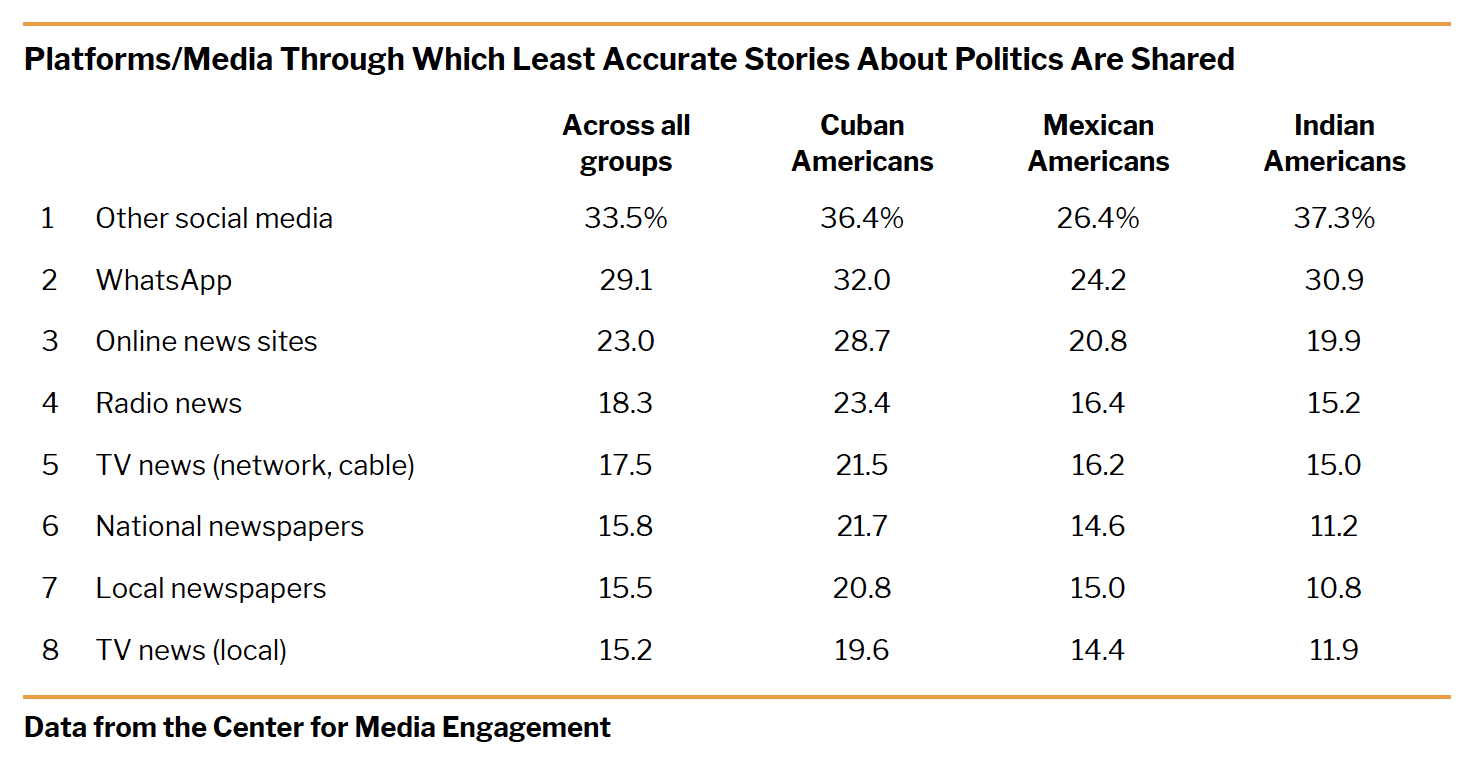 While social media platforms emerged as the most prevalent category, WhatsApp ranked relatively high, coming before online news sites, radio news, and network TV news. Local newspapers and local TV news came in last – meaning that they were comparably perceived as more accurate with regard to political stories than social media, WhatsApp, or online news sites.
While social media platforms emerged as the most prevalent category, WhatsApp ranked relatively high, coming before online news sites, radio news, and network TV news. Local newspapers and local TV news came in last – meaning that they were comparably perceived as more accurate with regard to political stories than social media, WhatsApp, or online news sites.
WhatsApp emerges as the most important messenger
While we only surveyed people who said that they used WhatsApp, the platform also emerged as the most popular among encrypted messenger and chat apps across all three groups. In line with previous, nationally representative research which shows that Americans who identify as Hispanic/Latino use WhatsApp comparably more than the national average, the present survey data suggest that Cuban Americans, Mexican Americans, and Indian Americans use WhatsApp often and on a daily basis (below table reports use of apps ‘several times a day’). While FB Messenger and iMessage also constitute important chat channels, Telegram and Signal were comparably much less relevant.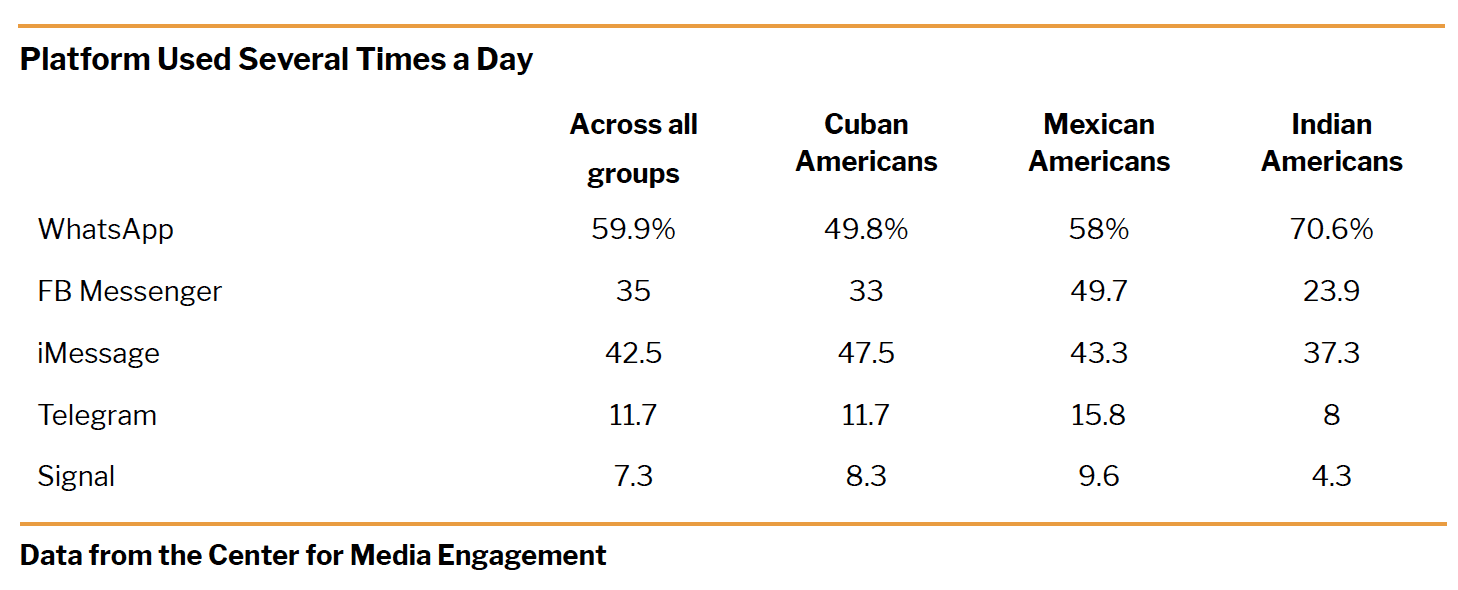 A high share of people were familiar with the notion of end-to-end encryption (E2EE), with Indian Americans at 78%, Mexican Americans at 62%, and Cuban Americans at 55.7%.
A high share of people were familiar with the notion of end-to-end encryption (E2EE), with Indian Americans at 78%, Mexican Americans at 62%, and Cuban Americans at 55.7%.
Among those who had heard of E2EE before, it was an important or very important feature of the app (78.4% among Cuban Americans, 82% among Mexican Americans, and 86.8% among Indian Americans).
(2) Investigating False or Misleading Narratives
Our survey also included a set of false or misleading narratives that were based on academic literature and public-facing news reports. We put these narratives to test and were interested in whether, and the extent to which, participants (a) encountered these narratives on WhatsApp, and (b) thought that the statements were true. The subsequent table reports the percentages of participants who said that they had encountered certain narratives. Importantly, the question wording was neutral and did not make suggestions about the veracity of the statements, nor did it insinuate in any way that participants would be asked a set of questions about falsehoods.33 The items are ranked based on the percentages across groups, but individual numbers are also reported for each diasporic community.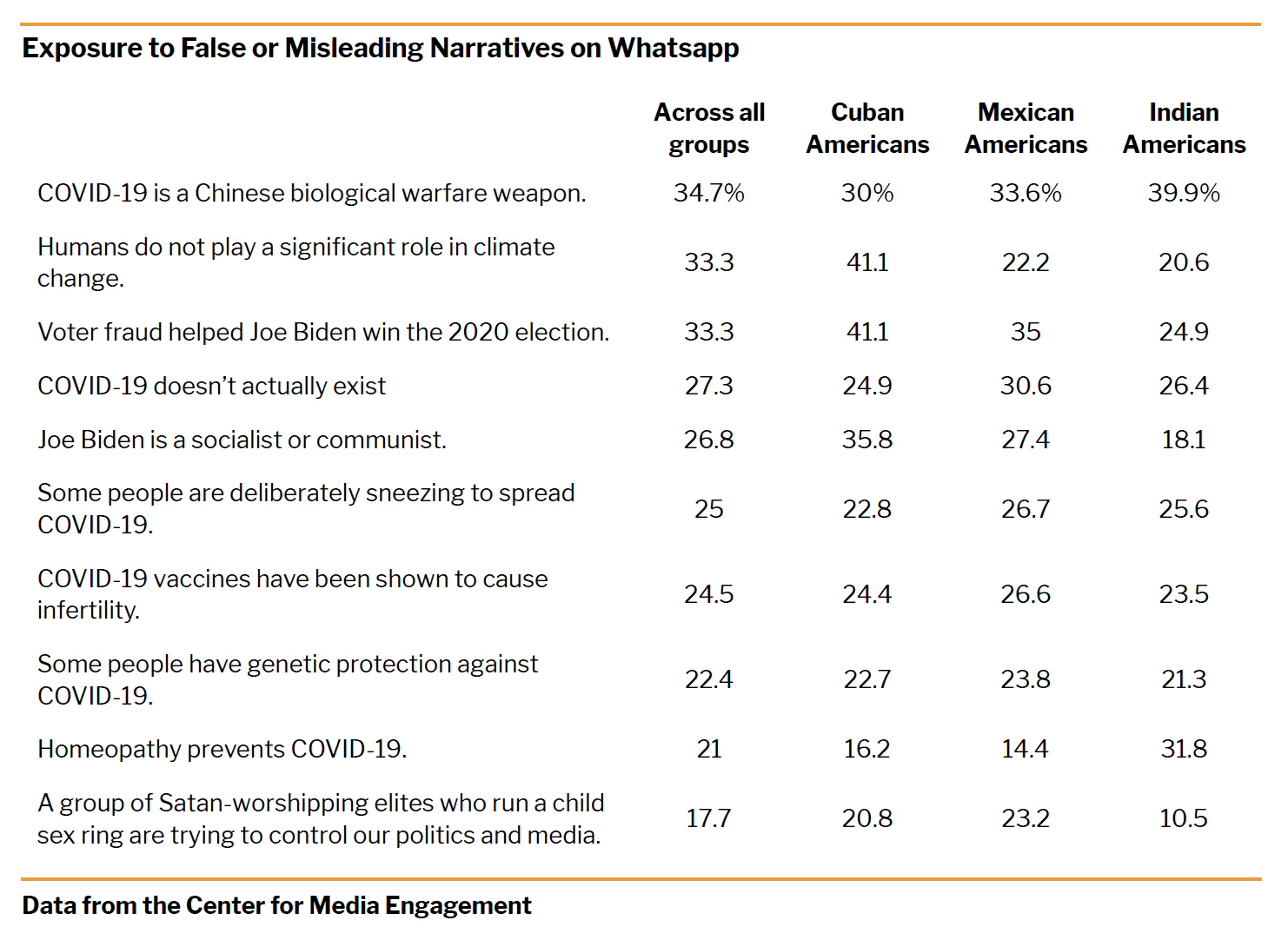 When comparing what members of the three diasporic communities read on WhatsApp, what stood out was that a substantive share of Indian Americans stated they read that COVID-19 is a Chinese biological warfare weapon. A large share of Cuban Americans stated they read that humans do not play a significant role in climate change. Furthermore, it was noteworthy that a large share of Cuban Americans stated they read that voter fraud helped Joe Biden win the election, and that Joe Biden was a socialist or communist. For Mexican Americans, a large share of participants said they read that COVID-19 does not actually exist, that voter fraud helped Joe Biden win the election, and that COVID-19 is a Chinese biological warfare weapon. Among Indian Americans, many read that homeopathy would prevent COVID-19. While about a fifth of Cuban Americans and Mexican Americans read about the QAnon conspiracy theory that a group of Satan-worshipping elites who run a child sex ring were trying to control politics and media, the number was only slightly above 10% among Indian Americans.
When comparing what members of the three diasporic communities read on WhatsApp, what stood out was that a substantive share of Indian Americans stated they read that COVID-19 is a Chinese biological warfare weapon. A large share of Cuban Americans stated they read that humans do not play a significant role in climate change. Furthermore, it was noteworthy that a large share of Cuban Americans stated they read that voter fraud helped Joe Biden win the election, and that Joe Biden was a socialist or communist. For Mexican Americans, a large share of participants said they read that COVID-19 does not actually exist, that voter fraud helped Joe Biden win the election, and that COVID-19 is a Chinese biological warfare weapon. Among Indian Americans, many read that homeopathy would prevent COVID-19. While about a fifth of Cuban Americans and Mexican Americans read about the QAnon conspiracy theory that a group of Satan-worshipping elites who run a child sex ring were trying to control politics and media, the number was only slightly above 10% among Indian Americans.
We were interested in whether people thought these statements were true or false. The confluence of having encountered information on WhatsApp, in combination with believing in the veracity of it, would naturally make false information all the more harmful. Below, we report percentages of how many people believed that these statements were ‘definitely’ or ‘probably’ true, as well as how many thought they were ‘definitely’ or ‘probably’ false.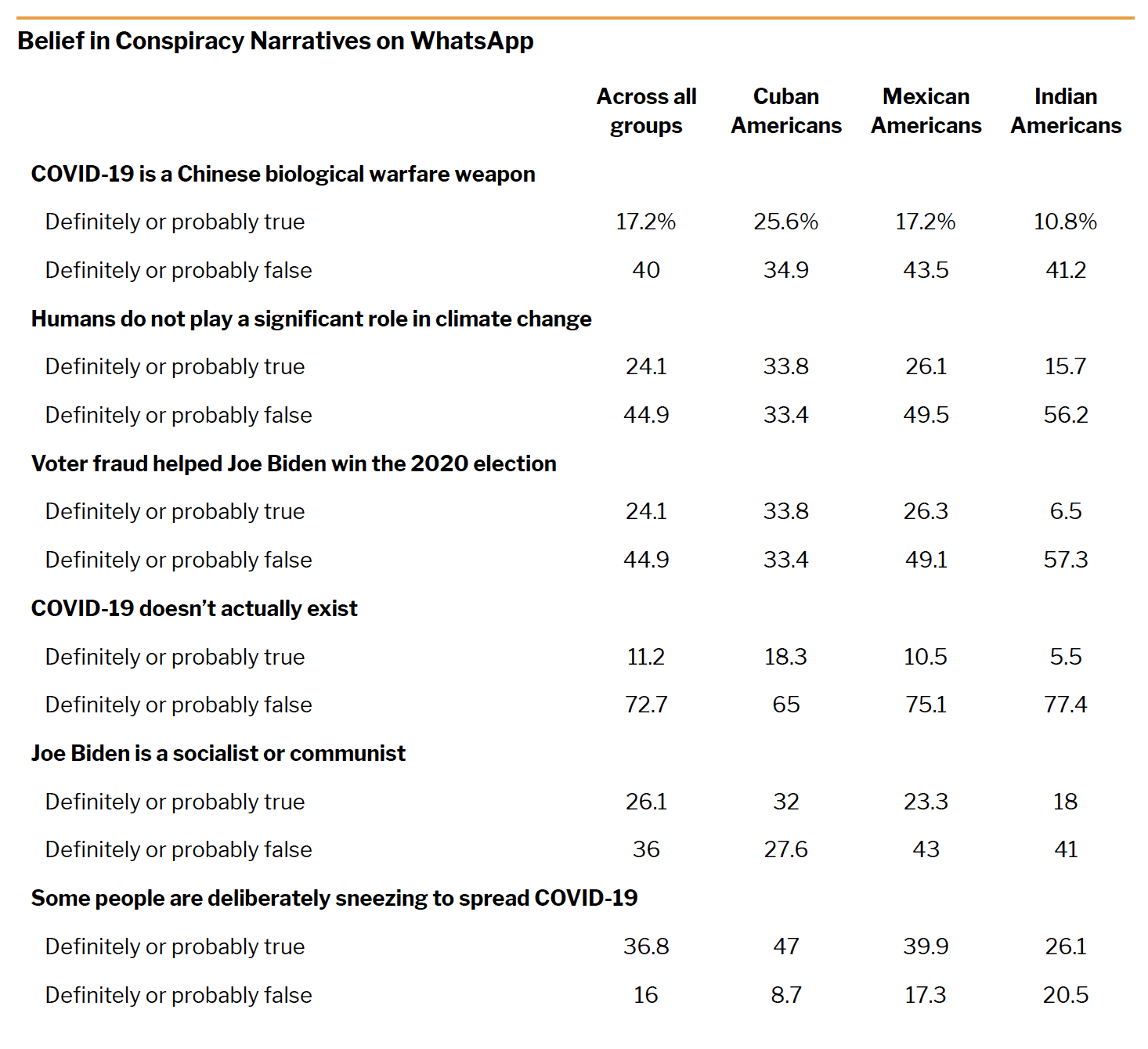
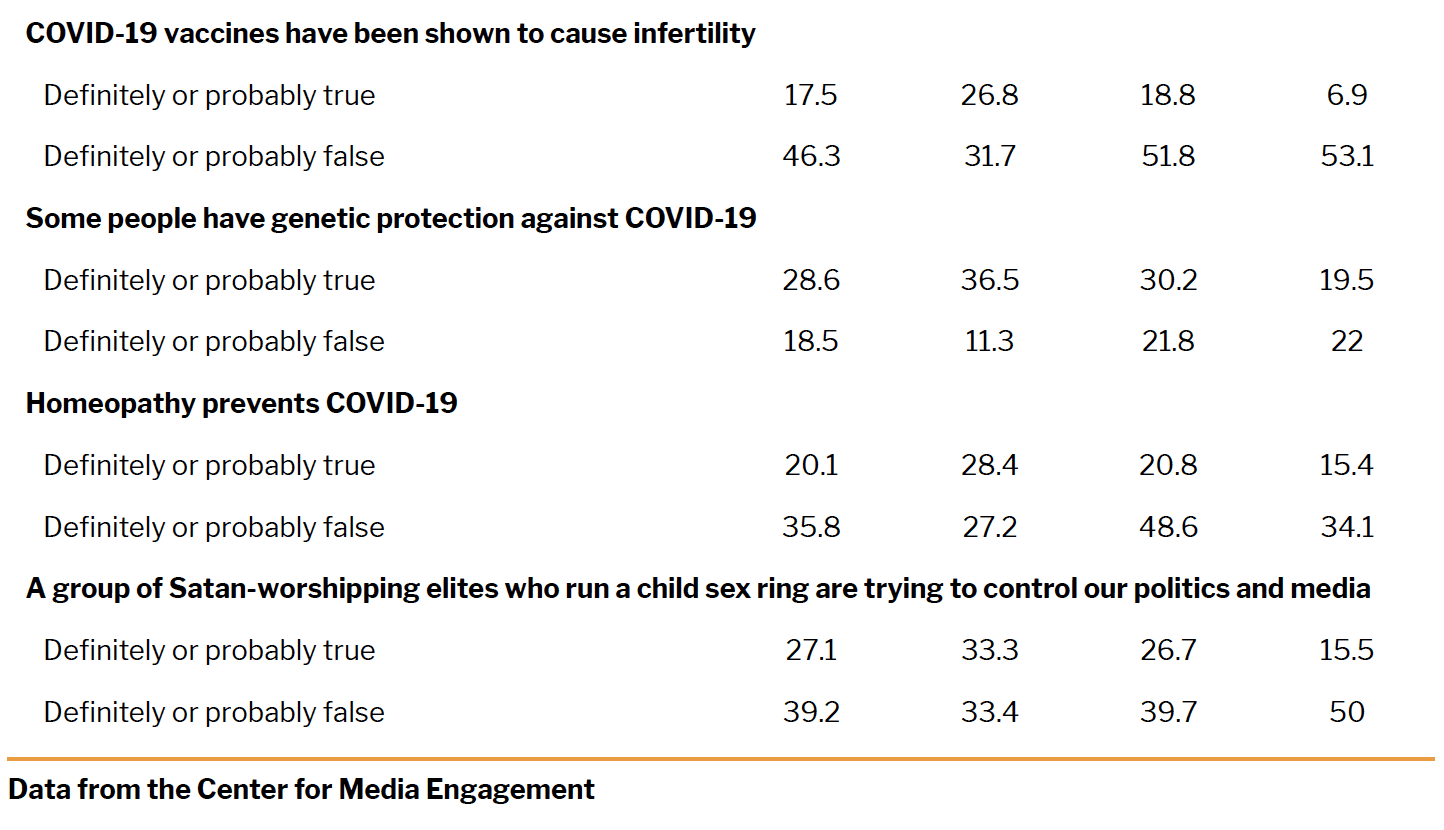
(3) WhatsApp is Crucial for Personal Use – But Politics is Discussed There, Too
Across the three diasporic communities that we surveyed, our study confirms that WhatsApp is first and foremost a critical medium for personal communication with friends and family. More than for news, entertainment, or work, participants said that they used WhatsApp for personal communication, community/group communication, and to stay in touch with family back home. Particularly among Indian Americans, this last category – staying in touch with family back home – stood out as the most significant function of the app.
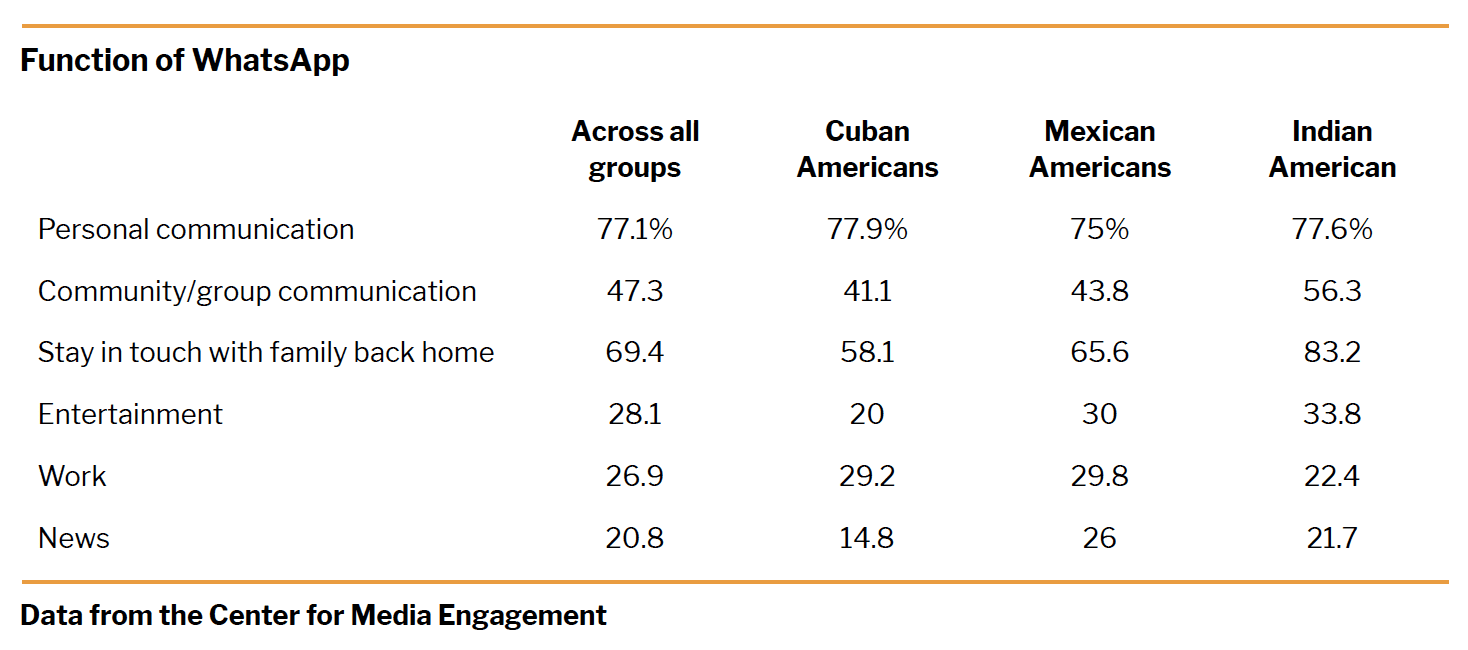 We were also interested in how often WhatsApp was used to share information about different aspects of private and public life. We surveyed the sharing frequency for content relating to personal and family life; work and studies; news and general current affairs; as well as political issues. Public issues such as news and political issues were less relevant to participants than content pertaining to personal and family life or work and studies. What stood out among groups was how WhatsApp emerged as more important to Mexican Americans for discussing civic issues (news and general current affairs, political issues) than for Cuban Americans or Indian Americans.
We were also interested in how often WhatsApp was used to share information about different aspects of private and public life. We surveyed the sharing frequency for content relating to personal and family life; work and studies; news and general current affairs; as well as political issues. Public issues such as news and political issues were less relevant to participants than content pertaining to personal and family life or work and studies. What stood out among groups was how WhatsApp emerged as more important to Mexican Americans for discussing civic issues (news and general current affairs, political issues) than for Cuban Americans or Indian Americans.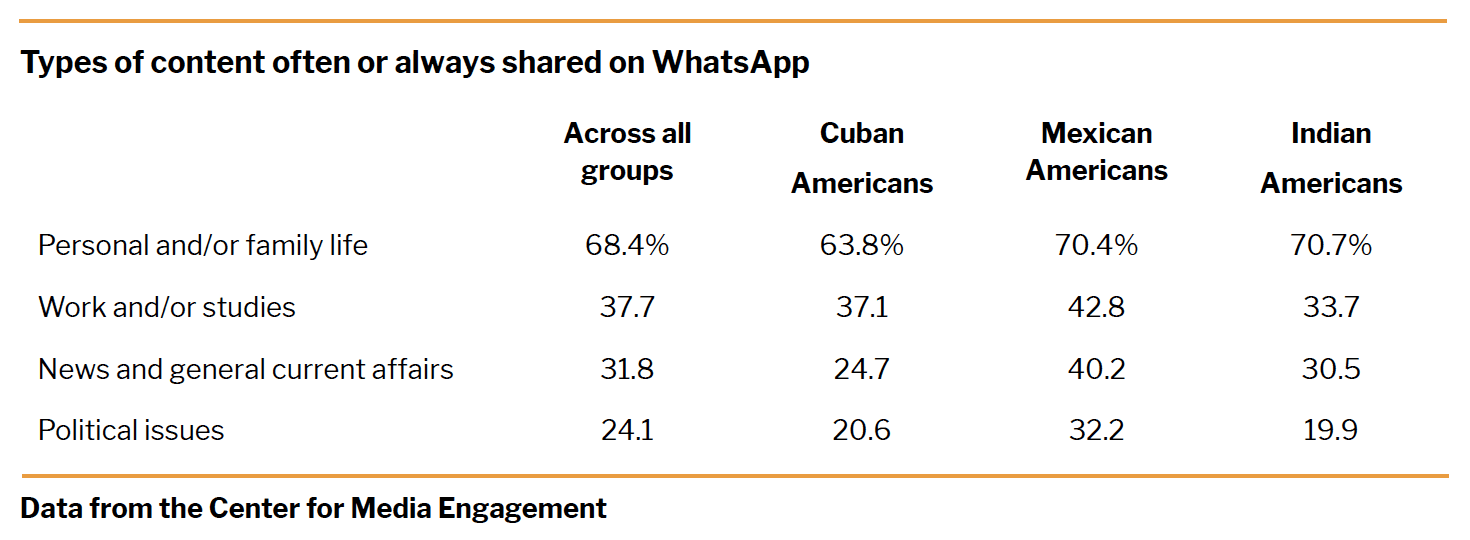
We prodded the degree to which participants thought the content on WhatsApp pertained to politics. About a quarter (25.2%) of Mexican Americans reported that they often or always encountered political content on WhatsApp, but only 16% of Cuban Americans, and 13.9% of Indian Americans said this was the case for them. Across all groups, the formats of content that were most often encountered34 were text (85.4%), followed by memes/ images (58.8%), videos (50%), and audio messages (38.8%). We were also interested in the role that forwarding messages to others plays on WhatsApp. When it came to receiving such forwarded content (‘often’ or ‘always’) on WhatsApp, Indian Americans emerged as receiving forwarded messages the most (54.2%), followed by Mexican Americans (34.4%), and Cuban Americans (28.7%).
People’s recent WhatsApp usage habits also revealed the primacy of the personal over the political – across groups, participants said they most often used WhatsApp for receiving news from friends (58.7%); followed by receiving news from Groups on WhatsApp (42%); staying informed about current events and public affairs (33%); getting additional information about what is going on in politics and public affairs (27.7%); and lastly, for receiving news from people that they didn’t know well (23.9%).
(4) False Information is Most Often Thought to Come from Strangers – But it Also Comes from Close Connections
Strangers were the group of people most often thought to be the sharers of false information. While WhatsApp, as our data show, is primarily used among friends and family, the perception that family members or close friends were the ones sharing false information was very heterogeneous across the three groups in this survey. Among Indian American survey takers, strangers were still the most prevalent category, but 31.9% of Indian Americans also said that family members shared false information, and 25.5% said that close friends did so.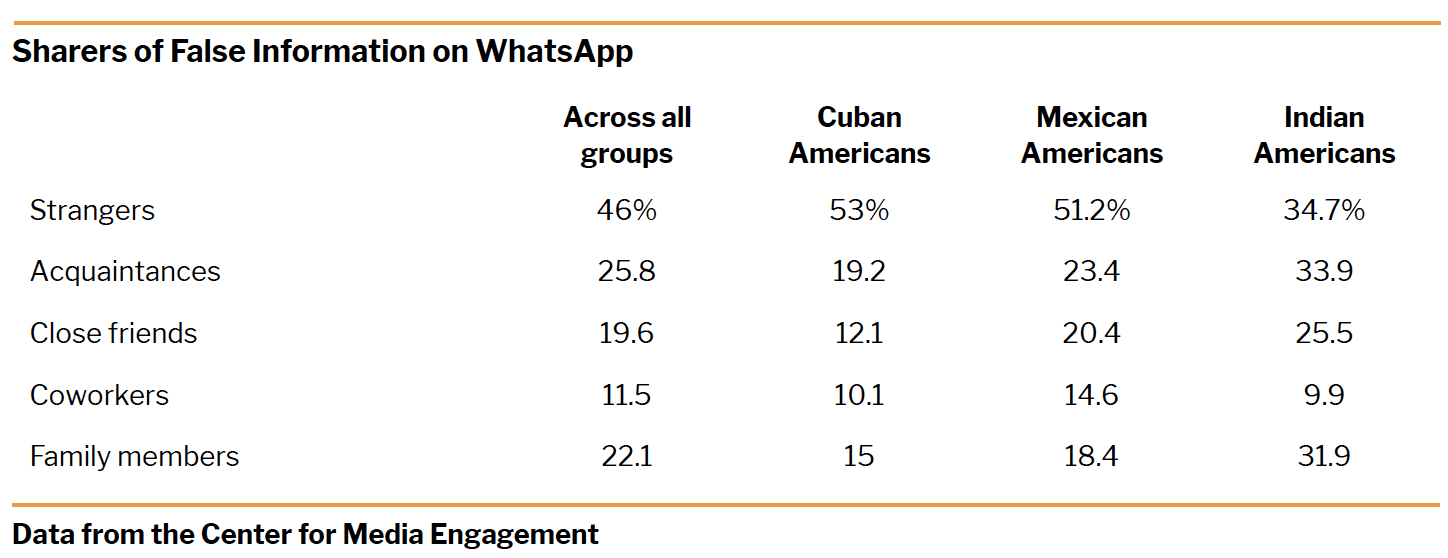
Participants themselves were cognizant of their own role in the spread of false information. This meant that they had shared content on WhatsApp that they did not read before sharing (23.1% across all groups), that they found out to be false after the fact (18.5% across groups), that seemed accurate at the time, but they later found out was exaggerated after they shared it (22.5% across groups). Across groups, 17.7% admitted that they had shared content despite already knowing that it was made up or exaggerated.
(5) People Think There is Little False Information Out There
One key variable that we were interested in exploring was the perception of encountering false information. As with all attitudinal research, it is important to acknowledge that what one person considers as false information may not match what others perceive as such. Across all groups, people reported low incidence levels of encountering false information (16.2% reported ‘often or always’). When looking into the specific differences between diasporic communities, Indian Americans stood out in that they stated – more than the other two groups – that they encountered false information being spread on WhatsApp. Across all three diasporic groups surveyed, false and misleading information about the news or current events received on WhatsApp ranked higher than most other forms of nefarious content and was only exceeded by scam or phishing content.
Across all three diasporic groups surveyed, false and misleading information about the news or current events received on WhatsApp ranked higher than most other forms of nefarious content and was only exceeded by scam or phishing content. 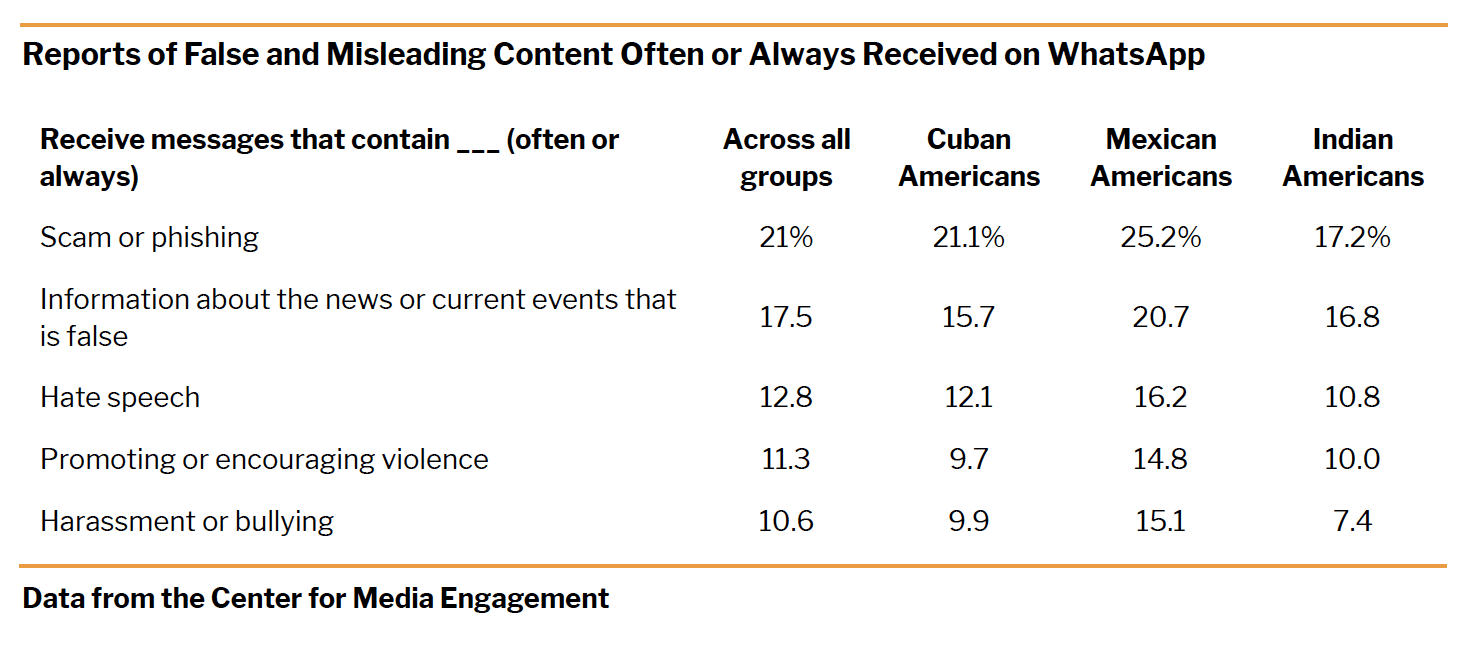
RESEARCH RATIONALE AND METHODOLOGY
Discussions of diaspora communities are often accompanied by a process of simplification, and of creating binaries where there are multiplicities. Descriptions of diaspora communities frequently use broad brushes and describe — ostensibly homogeneous — populations that are then defined by shared interest, motivations, and identifications with one’s motherland.34
By using the terms diaspora, diasporic, and diaspora communities, we do not want to simplify complicated intersectional identities.35 Instead, we critically apply the term diaspora community here to refer to shared experiences, attitudes, and perceptions of people with diasporic histories.
Immigrants connect not only to their new home but also sustain connections to the place that they came from. This allows for the formation of cultural enclaves that may escape the gaze of dominant hegemonic cultures.36 Returning to Appadurai, diasporas congregate in so-called diasporic public spheres.37 Contemporary examples of this include, for example, the Facebook group “Subtle Asian Traits” which attracts members of Asian diasporas and allows them to share experiences of racism and how to cope with it,38 WhatsApp groups through which Arabic diaspora communities in Switzerland communicate about politics,39 WhatsApp as an information-sharing tool for Syrian refugees in Amman,40 Syrians in Italy,41 Nigerians in the U.S.,42 or WeChat blogs for Chinese Americans.43 Such diasporic media and platforms are important for people who may be in “search for the new cultural identity versus preserving the old one.”44
Honing in on Three Diasporic Communities
We selected the three diasporic communities of Cuban Americans, Mexican Americans, and Indian Americans based on data published by the Pew Research Center.45 Based on 2018 American Community Survey data from the U.S. census, Pew established that the five countries with the largest percentage of immigrants among eligible U.S. voters were Mexico (3.5 million voters), the Philippines (1.4 million), India (1.2 million), Vietnam (1.0 million), and Cuba (0.8 million). Among these five, we then selected diaspora and immigrant communities in whose respective home countries and cultures WhatsApp played an important role, and which were targeted by political campaigns and false information. The Reuters Digital News Report presents representative WhatsApp usage data for Mexico, and non-representative data for an English sample of Indians. For Cuba, no such data is available. Based on the Reuters report, in 2022, 72% of Mexicans and 76% of Indians used WhatsApp.46 This empirical gap on Cuba – and, to some extent, Cuban Americans – and WhatsApp serves as a motivating factor for including this population in our study. Focusing on Cuban Americans is especially relevant as, in 2020, both the Trump and Biden campaigns heavily targeted Cuban American voters, a development which also was accompanied by ample political misinformation.47 In 2020, misleading information also targeted Indian Americans48 and Hispanics,49 establishing these three groups as important diasporic communities to study.
Cuban Americans
Cuban Americans constitute an important Latino diasporic community in the United States. They are geographically concentrated primarily in South Florida, particularly in Miami- Dade County,50 but are also located in other parts of the country and have built prominent communities in New Jersey and California.51 Cuba and South Florida are historically connected – for example, through the Spanish-American War.52 Significant migration to the U.S. from the island happened after the Cuban revolution in 1959, an uprising led by Fidel Castro that established a Communist authoritarian regime in the country.53 A second significant wave of immigrants is connected to the Mariel boatlift in 1980, during which many people fled Castro’s Cuba to the U.S. on boats.54 More recent migration from Cuba to the U.S. is tethered to economic reasons and recent immigrants “have stronger and more active ties with the island”55 than political ‘exiles,’ the term most commonly used before ‘Cuban diaspora’ was popularized.56 Among current-day Cuban Americans in South Florida, 70% say that they have relatives or significant others in Cuba,57 which is important when considering their communication over WhatsApp, through which Cubans on the island stay connected with members of the diaspora.
A combination of factors – including a geo-strategically important location in the Caribbean, wealth from sugar trade, and the historical importance of Havana during colonial times – all contributed to the notion of Cuban exceptionalism.58 The United States framed Cuban refugees as ‘good’ immigrants – as ideologically aligned against communism, as white, and as upper middle class59 – which still has bearings today. Cuban Americans stand out among other Latino communities in their high degree of political participation and voter turnout.60The group also serves as a counterfactual to what media organizations often tout as a homogenous “Latino vote.” For example, when compared to being Mexican American, being Cuban American correlates with favoring Donald Trump.61 Cuban Americans, over the years, have been a strong bastion of support for the Republican Party.62 And while research has shown that group threat emanating from Trump’s xenophobic antics can be a motivator for Latino communities to rally against Trump, this only works in cases where there is a perception of shared identity, fate, and the perception that Latinos are one racialized group.63
Trumpism resonates with Cuban Americans as it appeals at an emotional level and connects to the American Dream and aspirations of upward mobility combined with reactions to Communism.64 Although one could assume that post-Mariel generations of Cuban Americans who immigrated to the United States in the more recent past would identify as more progressive, and that anti-communist attitudes would play much less of a role for them, ideologically this has thus far not proven true.65 In fact, recently-immigrated Cuban Americans registered even more often as Republican. In 2020, 53% of the Cuban-American registered voter population in South Florida was Republican (23% Democrat). Among new arrivals (2010-2015), 76% were registered as Republicans, compared to 49% among cohorts who arrived between 1995 and 2009.66
Cuba itself is defined by strong governmental control over means of communication and internet infrastructures.67 This combination of “political censorship, high costs, slow speeds, and limited access”68 has led to innovative and unique forms of media distribution, such as the informal, illegal “El Paquete,” a large data package that gets distributed at low cost and which carries copies of recent film, music, and information.69 The internet has existed in Cuba since 1996;70 in 2015, according to Cuban government statistics, 34.8% of the population had access to it.69 Cubans possess sophisticated information and communication technology skills, but access still remains difficult.71 Important pathways for diasporic communication between Cubans in Cuba and Cubans elsewhere are constituted by blogs71 and communication platforms such as WhatsApp.
Indian Americans
Indian Americans constitute the second largest immigrant group in the United States and are an important diasporic community.72 Among Asian American73 groups in the U.S., Indian Americans are only exceeded by Chinese Americans in number74 with significant populations of Indian Americans living (in the 2014-2018 time frame) in California, New Jersey, New York, Illinois, and Georgia.75 Significant events for Indian immigration into the United States are marked by the Luce-Celler Act of 1946, which allowed 100 Indians per year to immigrate to the U.S., and also allowed a path to naturalization.76 Furthermore, the Immigration and Nationality Act of 1965 was another main stepping stone for immigration from India (as well as from many other countries) into the U.S.77 Student migration (Indians constitute the second largest country among foreign student populations in the U.S.), in addition to immigration in the technology sector (which produces highly skilled personnel), are more recent dynamics that define Indian immigration to the U.S.78
A persistent narrative Indian Americans are faced with is that of a ‘model minority,’ which is more generally applied to Asian Americans writ large.79 To be Indian American means to navigate identities drawing on a vast “diversity of languages, ethnicities, and religions in different parts of India.”80 Indian Americans also continually face anti-Indian racism and hate crimes. For example, when Nina Davuluri became the first Indian American to win the Miss America beauty pageant in 2014, she was targeted by racist tweets.81 In 2017, a man shot two Indian Americans and killed one in a bar in Kansas.82
Historically, Indian Americans have been strong supporters of the Democratic Party,83 while at the same time supporting Modi’s Bharatiya Janata Party more than the Congress party. As to why this support for the Democratic party is so pronounced, some have argued that the perception of the Republican Party as “intolerant of minorities”84 plays an important role.
Indian Americans were identified by both the Republican and Democratic Party in 2020 as an important part of the electorate, including in local politics,85 and the Indian diasporic community has been referred to as “an emerging political force.”86 Indian Americans have occupied some of the highest offices in the United States: Republican Nikki Haley was governor of South Carolina and U.S. ambassador to the U.N.; her Republican colleague Bobby Jindal was Governor of Louisiana; and Democrat Kamala Harris is currently the Vice President of the United States.87
While diasporic media for Indian Americans encompass a great many channels, particularly important for communication is the encrypted messaging and chat app WhatsApp, which is also an avenue on which a lot of false and misleading information is spread.88
Mexican Americans
According to the most recent data available, Mexican Americans represent 11.33% of the
U.S. population. This percentage comprises people who are both born in the U.S. (70.64%) or are foreign born (29.36%).89 Place of birth is an important variable because it may influence sense of identity. While later generations tend to increasingly identify as Americans, many Mexicans Americans identify with a national or binational sense of self. These different senses of identity have implications for media use. Older immigrants often connect with their homeland identity by using homeland media. Younger generations are more likely to consume U.S. media, although their families may play a role in pushing consumption of homeland media.90 These patterns are similar when it comes to social media usage. Mexican Americans use social media to connect with family and friends in Mexico, but also to talk to their in-group community.91
Sense of identity also influences political behavior. For example, during the civil rights movement many Mexican Americans adopted the term “Chicano,” embracing their indigenous identity and giving new meaning to a word that previously had a negative connotation.92 This politically active generation of the 60s and 70s, however, is not representative of the entire population of Mexican Americans. The North American Free Trade Agreement (NAFTA) of 1994, which created a trade bloc between Mexico, Canada, and the United States, led to the immigration of many Mexicans who had weaker ties to the United States, and consequently, were less politically active in their new home. Historical problems with obtaining U.S. citizenship are associated with lower voting turnout among Mexican Americans when compared to other Hispanic populations, such as Cuban Americans and Puerto Ricans.93 Meanwhile, Mexican American identity politics center three domains: Race, class, and culture.94 While Mexican Americans have traditionally been Democrats, Mexican Americans who do not see themselves as immigrants heavily supported Donald Trump’s candidacy.95
Mexican immigration into the United States has been “a consistent animating issue for the right wing”96 in America. In this vein, Mexicans received flagrantly racist public attention when, in a 2015 speech, then-presidential candidate Donald J. Trump proclaimed that Mexicans coming to the United States were ‘rapists’ and ‘drug dealers.’”97 This directly aligns with racial profiling and a threat narrative about Mexicans that U.S. media have continued to propagate.98 Mexican American voters in the United States were also targeted after the 2016 U.S. presidential election, for example, by the Russian Internet Research Agency troll farm’s “Brown Power” campaign.99 The 2020 U.S. election, in particular, saw the sharing of false information – about COVID-19, Joe Biden, and QAnon – across many platforms in Spanish.100 WhatsApp constitutes an important communication platform for Mexican Americans – allowing communication with friends and family within the United States and beyond. Simultaneously, research has documented a rise in false information spread on the platform,101 false information which may utilize structural inequities, for instance, regarding how the medical system in the U.S. propagates racism.102 Our study specifically hones in on WhatsApp and its role in the spread of false and misleading information.
Methodology
We fielded a survey with CloudResearch (formerly known as TurkPrime), a panel provider and crowdsourcing platform known to implement strong data quality checks.103 The platform draws on a range of participant panels in the United States,104 including outside of Amazon Mechanical Turk. We recruited 1,544105 participants into a cross-sectional survey design that was neither random nor representative, but instead consisted of people who self-identified as Cuban American or Cuban (n=506), Indian American or Indian (n=554), or Mexican American or Mexican (n=500)106, and who said that they used the encrypted chat and messaging platform WhatsApp.107 A particularly hard-to-reach population, very little is known about WhatsApp users, their demographics, and their usage patterns. Our research study constitutes, to our knowledge, one of the first quantitative forays and helps expand knowledge about the platform and the people who use it.108
The survey was administered online using the software package Qualtrics. It was fielded between April 27 and June 14 of 2022 in the United States. Survey funding was provided by the John S. and James L. Knight Foundation as part of the Center for Media Engagement’s connective democracy initiative.109 Participants who were recruited into the survey by CloudResearch were provided with a consent form110 outlining the purpose of the study.
Participants answered questions pertaining to sociodemographics and social media use and attitudes, in particular concerning WhatsApp. Questions also pertained to false and misleading information online and participants’ political attitudes.111 The data were analyzed using the software package SPSS.
CONCLUSION AND RECOMMENDATIONS
Our analysis supports existing research pinpointing the critical role that WhatsApp plays as an infrastructure for close connections and intimate networks of communication between friends and family.26 Diasporic community members across all three communities in this survey – Indian Americans, Cuban Americans, and Mexican Americans – used it less for political discussion, and more for staying connected with friends and family, including with people back home. Notwithstanding, both political talk and discussion of news events still happen and get shared on the platform.
People perceived WhatsApp as ranking high among venues where people thought the least accurate stories about politics were shared: WhatsApp came immediately after social media and before online and radio news. This underscores that the app continues to play an important role in the spread of false and misleading political information.
Our survey data also showed a moderately high prevalence of conspiracy and false narratives that people across all three diasporic communities had read and encountered on WhatsApp. Fact-check initiatives with specific community, language, and platform expertise, such as Factchequeado112 for Latino communities in the United States, and monitoring tools such as WhatsApp monitor,113 are important tools for intervention for researchers, journalists, and audiences alike that can provide specific, contextual information debunking narratives that are circulating on platforms. Incentivizing more such efforts – and funding them – should be an immediate policy goal for those trying to combat the spread of false information in encrypted messaging spaces such as WhatsApp.
While strangers were thought of as sharing false information the most, friends and family members were considered important sharers as well. Paradoxically, though in line with research pinpointing how people think others are more affected than themselves,114 those surveyed in our study thought that there was not much false information circulating on WhatsApp, yet at the same time, a substantive share of research participants stated they believed in some of the conspiracy narratives they were asked about. Appealing to individual users to address false information immediately when they encounter it, therefore, is key. For instance, when a family member shares something on WhatsApp that is clearly false, it is better to jump right in and start a conversation than to let it continue to circulate. Initiatives that focus on equipping all WhatsApp users with community moderation skills are a key area in this regard.115 Projects addressing community moderation literacy already exist,116 but making those resources readily available, accessible, and translated in all languages that platform users might need is an important area in need of growth and investment.
ACKNOWLEDGMENTS
The authors thank Arthur D. Soto-Vásquez, Hannah Artmann, as well as Inga Trauthig, for providing extensive feedback on previous versions of this paper. Thank you also to all Cuban American, Mexican American, and Indian American survey participants who contributed to this work by taking the survey. This study is a project of the Center for Media Engagement (CME) at The University of Texas at Austin and is supported by the Open Society Foundations, Omidyar Network, John S. and James L. Knight Foundation, and The Miami Foundation. Any opinions, findings, conclusions, or recommendations expressed in this material are those of the authors and do not necessarily reflect the views of the funding bodies.
SUGGESTED CITATION:
Riedl, M. J., Ozawa, J. V. S., Woolley, S., & Garimella, K. (October 2022). Talking Politics on WhatsApp: A survey of Cuban, Indian, and Mexican American diaspora communities in the United States. Center for Media Engagement. https://mediaengagement.org/research/cuban-indian-mexican-american- communities-in-the-united-states
APPENDIX 
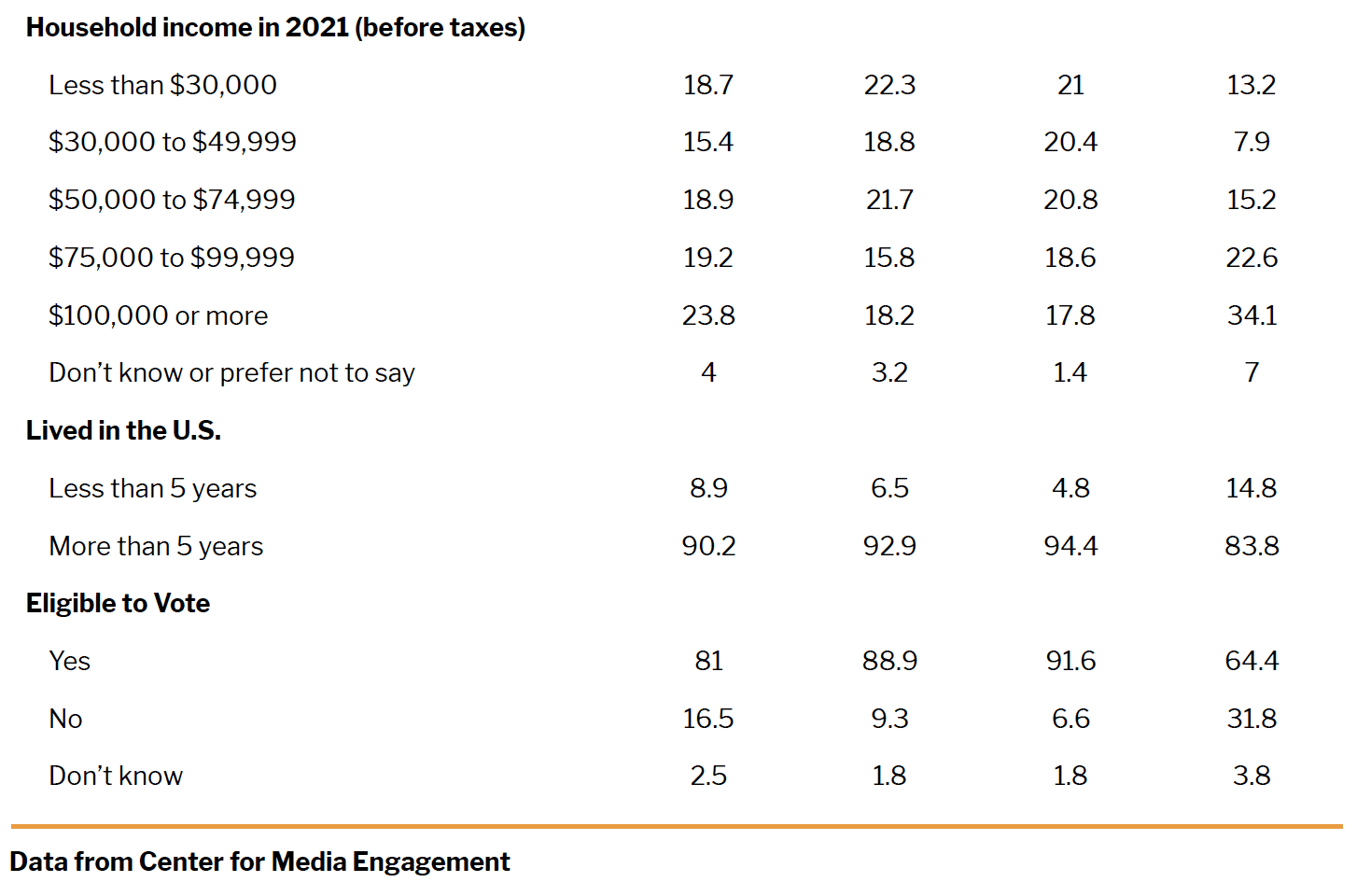
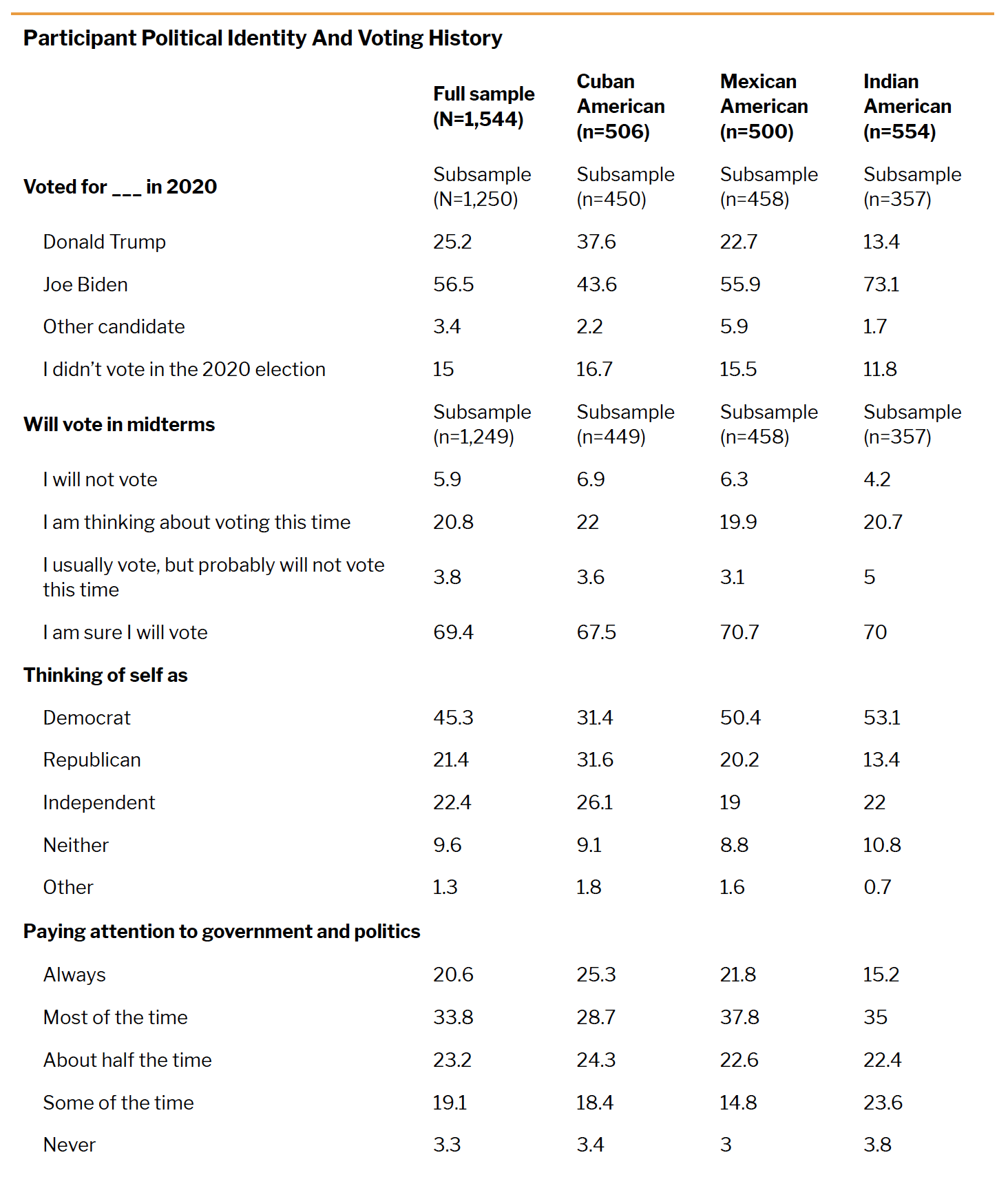
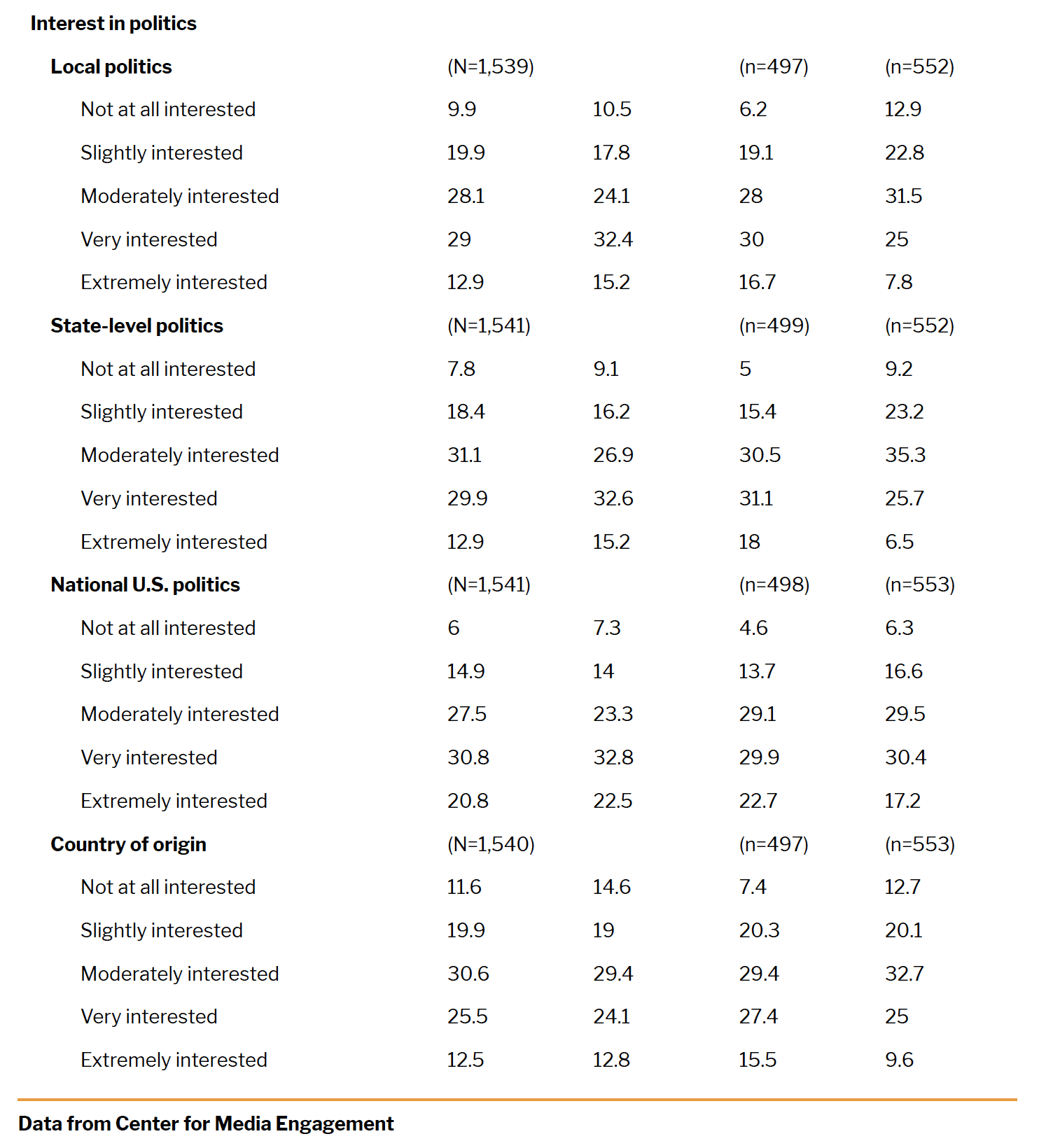
- Ruiz, N. G., Shao, S., & Shah, S. (2022). What it means to be Asian in America. Pew Research Center. https://www. pewresearch.org/race-ethnicity/2022/08/02/what-it-means-to-be-asian-in-america/.[↩]
- Karim, K. H. (1998). From ethnic media to global media: Transnational communication networks among diasporic communities. International Comparative Research Group Strategic Research and Analysis. Working Paper WPTC-99- 02, International Comparative Research Group Strategic Research and Analysis Canadian Heritage.[↩]
- Appadurai, A. (1996). Modernity at large: Cultural dimensions of globalization. University of Minnesota Press.[↩]
- Mallapragada, M. (2006). Home, homeland, homepage: Belonging and the Indian-American web. New Media & Society, 8(2), 207–227. https://doi.org/10.1177/1461444806061943.[↩]
- Lopez, M. H. (2022). U.S. 2022 Midterm elections: Latino voters. U.S. State Department Foreign Press Corps Briefing. https://www.state.gov/briefings-foreign-press-centers/midterm-elections-latino-voter.[↩]
- Bernal, R. (2022, September 8). GOP touts 5,000 events at minority community centers. The Hill. https://thehill. com/latino/3633270-gop-touts-5000-events-at-minority-community-centers/.[↩]
- Ortegon, M. (2022). Latino communities on the front lines of voter suppression. Brennan Center for Justice. https://www.brennancenter.org/our-work/analysis-opinion/latino-communities-front-lines-voter-suppression.[↩]
- In May 2022, WhatsApp announced the increase in maximum group size to 512 people, a move that they company says it made in response to user requests; WhatsApp (2022). Reactions, 2GB file sharing, 512 groups. WhatsApp Blog. https://blog.whatsapp.com/reactions-2gb-file-sharing-512-groups.[↩]
- We acknowledge that Meta has been discussing the introduction of E2EE to many of its chat functionalities across properties (e.g., Messenger, Instagram Messages, etc.); this process, however, is not complete as of the publication of this white paper.[↩]
- Rossini, P., Stromer-Galley, J., Baptista, E. A., & Veiga de Oliveira, V. (2021). Dysfunctional information sharing on WhatsApp and Facebook: The role of political talk, cross-cutting exposure and social corrections. New Media and Society, 23(8), 2430–2451. https://doi.org/10.1177/1461444820928059.[↩]
- WhatsApp. (2020). Two billion users – connecting the world privately. WhatsApp Blog. https://blog.whatsapp. com/two-billion-users-connecting-the-world-privately/?lang=en.[↩]
- eMarketer. (2019, September 23). WhatsApp is becoming a key driver of mobile messaging growth. Insiderintelligence.com. https://www.insiderintelligence.com/content/whatsapp-is-becoming-a-key-driver-of- mobile-messaging-growth.[↩]
- Auxier, B., & Anderson, M. (2021). Social media use in 2021. Pew Research Center. https://www.pewresearch.org/ internet/wp-content/uploads/sites/9/2021/04/PI_2021.04.07_Social-Media-Use_FINAL.pdf.[↩]
- We use the term “Hispanic” when we reference materials that also use this term, for example, survey studies. As Salinas and Lozano (2019) point out, both “Latino” as well as “Hispanic” are “pan-ethnic terms (…) that (…) both refer to a cultural and ethnic group, not a race;” Salinas, C., & Lozano, A. (2019). Mapping and recontextualizing the evolution of the term Latinx: An environmental scanning in higher education. Journal of Latinos and Education, 18(4), 302–315. https://doi.org/10.1080/15348431.2017.1390464, p. 303. As they further point out, the term Hispanic traces its lineage to the U.S. census introducing a term for all people who hail from Spanish-speaking countries, whereas Latin/Latino/Latinx refers to people (of mixed-race) from Central or Latin America, regardless of what local languages may be spoken. In our survey, we followed the National Content Test recommendation of a combined race/ethnicity question asked through a single item, with the category being “Hispanic, Latino, or Spanish.” Participants could, of course, select multiple categories aside from this one (other categories were: “White,” “Black or African American,” “Asian,” “American Indian or Alaska Native,” “Middle Eastern or North African,” “Native Hawaiian or other Pacific Islander,” and the open-ended category “Some other race or ethnicity;” Croll, P. R., & Gerteis, J. (2019). Race as an open field: Exploring identity beyond fixed choices. Sociology of Race and Ethnicity, 5(1), 55–69. https://doi.org/10.1177/2332649217748425; Mathews, K., Phelan, J., Jones, N. A., Konya, S., Marks, R., Pratt, B. M., Coombs, J., & Bentley, M. (2017). 2015 National content test: Race and ethnicity analysis report. https://www2.census.gov/programs-surveys/decennial/2020/program-management/final-analysis- reports/2015nct-race-ethnicity-analysis.pdf; Telles, E. (2018). Latinos, race, and the U.S. Census. Annals of the American Academy of Political and Social Science, 677(1), 153–164. https://doi.org/10.1177/0002716218766463.[↩]
- Auxier & Anderson.[↩]
- Gursky, J., Riedl, M. J., Joseff, K., & Woolley, S. (2022). Chat apps and cascade logic: A multi-platform perspective on India, Mexico, and the United States. Social Media + Society, 8(2), 1–11. https://doi. org/10.1177/20563051221094773; Gursky, J., Riedl, M. J., & Woolley, S. (2021, March 19). The disinformation threat to diaspora communities in encrypted chat apps. Brookings Tech Stream. https://www.brookings.edu/ techstream/the-disinformation-threat-to-diaspora-communities-in-encrypted-chat-apps/.[↩]
- Vosoughi, S., Roy, D., & Aral, S. (2018). The spread of true and false news online. Science, 359(6380), 1146–1151. https://doi.org/10.1126/science.aap9559.[↩]
- Ong, J. C., & Cabañes, J. V. A. (2019). When disinformation studies meets production studies: Social identities and moral justifications in the political trolling industry. International Journal of Communication, 13, 5771–5790. https://ijoc.org/index.php/ijoc/article/view/11417.[↩]
- Allcott, H., & Gentzkow, M. (2017). Social media and fake news in the 2016 election. Journal of Economic Perspectives, 31(2), 211–236. https://web.stanford.edu/~gentzkow/research/fakenews.pdf.[↩]
- Camargo, C. Q., & Simon, F. M. (2022). Mis- and disinformation studies are too big to fail: Six suggestions for the field’s future. Harvard Kennedy School Misinformation Review, 3(5). https://doi.org/10.37016/mr-2020-106; Kuo, R., & Marwick, A. (2021). Critical disinformation studies: History, power, and politics. Harvard Kennedy School Misinformation Review, 2(4). https://doi.org/10.37016/mr-2020-76.[↩]
- Wardle, C. (2019). First Draft’s essential guide to understanding information disorder. First Draft News. https:// firstdraftnews.org/wp-content/uploads/2019/10/Information_Disorder_Digital_AW.pdf?x47711.[↩]
- Woolley, S. C., & Howard, P. N. (Eds.). (2018). Computational propaganda: Political parties, politicians, and political manipulation on social media. Oxford University Press.[↩]
- Baulch, E., Matamoros-Fernández, A., & Suwana, F. (2022). Memetic persuasion: and WhatsAppification in Indonesia’s 2019 presidential election. New Media and Society. Advance online publication. https://doi. org/10.1177/14614448221088274.[↩]
- Nizaruddin, F. (2021). Role of public WhatsApp groups within the Hindutva ecosystem of hate and narratives of “CoronaJihad.” International Journal of Communication, 15, 1102–1119. https://ijoc.org/index.php/ijoc/article/ viewFile/16255/3370.[↩]
- Evangelista, R., & Bruno, F. (2019). Whatsapp and political instability in Brazil: Targeted messages and political radicalisation. Internet Policy Review, 8(4), 1–23. https://doi.org/10.14763/2019.4.1434.[↩]
- Gursky et al. 2022.[↩][↩]
- Nguyễn, S., Kuo, R., Reddi, M., Li, L., & Moran, R. (2022). Studying mis- and disinformation in Asian diasporic communities: The need for critical transnational research beyond Anglocentrism. Harvard Kennedy School Misinformation Review, 3(2). https://doi.org/10.37016/mr-2020-95.[↩]
- Gursky et al. 2021; Gursky et al. 2022; Trauthig, I. K., & Woolley, S. (2022). Escaping the mainstream? Pitfalls and opportunities of encrypted messaging apps and diaspora communities in the U.S. Center for Media Engagement, University of Texas at Austin. https://mediaengagement.org/research/encrypted-messaging-apps-and-diasporas.[↩]
- Kuo & Marwick.; Asian American Disinformation Table. (2022). Power, platforms, and politics: Asian Americans and disinformation. https://www.asianamdisinfo.org/wp-content/uploads/2022/08/AsianAmDisinformation_ LandscapeReport2022.pdf.[↩]
- The items that we asked in the survey included the following: “Have you read on WhatsApp that COVID-19 vaccines have been shown to cause infertility?” based on Dresevic, E. (2021, April 14). The vaccine against COVID-19 DOES NOT cause sterility. UNICEF Montenegro. https://www.unicef.org/montenegro/en/stories/vaccine-against-covid-19-does-not-cause-sterility; Hickok, K. (2021, October 12). The Covid vaccine doesn’t cause infertility, but the disease might. NBC News. https://www.nbcnews.com/health/sexual-health/covid-vaccine-doesnt-cause-infertility-disease-might-rcna2868; Kaiser Family Foundation (2021, October). KFF COVID-19 Vaccine Monitor October 2021. https://files.kff.org/attachment/TOPLINE-KFF-COVID-19-Vaccine-Monitor-October-2021. pdf; Wesselink, A. K., Hatch, E. E., Rothman, K. J., Wang, T. R., Willis, M. D., Yland, J., Crowe, H. M., Geller, R. J., Willis, S. K., Perkins, R. B., Regan, A. K., Levinson, J., Mikkelsen, E. M., & Wise, L. A. (2022). A prospective cohort study of COVID-19 vaccination, SARS-CoV-2 infection, and fertility. American Journal of Epidemiology, 191(8), 1383- 1395. https://doi.org/10.1093/aje/kwac011; “Have you read on WhatsApp that COVID-19 is a Chinese biological warfare weapon?,” based on Badrinathan, S., & Chauchard, S. (2022). Religious messaging against COVID-19 misinformation: Experimental evidence from India. [Unpublished Manuscript]. https://sumitrabadrinathan. github.io/Assets/paper-covid.pdf; “Have you read on WhatsApp that some people have genetic protection against COVID-19?” based on Badrinathan & Chauchard; “Have you read on WhatsApp that some people are deliberately sneezing to spread COVID-19?” based on Badrinathan & Chauchard; “Have you read on WhatsApp that homeopathy prevents COVID-19?” based on Badrinathan & Chauchard; “Have you read on WhatsApp that COVID-19 doesn’t actually exist?” based on Lynas, M. (2020, April 20). COVID: Top 10 current conspiracy theories. Alliance for Science, Boyce Thompson Institute, Cornell University. https://allianceforscience.cornell.edu/ blog/2020/04/covid-top-10-current-conspiracy-theories/; Wang, J., & Kim, S. (2021). The paradox of conspiracy theory: The positive impact of beliefs in conspiracy theories on preventive actions and vaccination intentions during the COVID-19 pandemic. International Journal of Environmental Research and Public Health, 18(22), 11825. https:// doi.org/10.3390/ijerph182211825; “Have you read on WhatsApp that Joe Biden is a socialist or communist?” based on Grinspan, L. (2021, October 21). How Spanish-Language Radio Helped Radicalize A Generation Of Miami Abuelos. The Huffington Post. https://www.huffpost.com/entry/miami-spanish-language-radio-misinfo rmation_n_616dbd3ee4b005b245c0b57e; ProsperoLatino, Latina Comunica, Florida Rising, & Miami Freedom Project (2021). Disinformation in Miami after the Capitol insurrection. https://docs.google.com/document/ d/1lLrAG2vPWgwa9fCvcmt-CP7r06ZGAQ_VYVaVB39F8LQ/edit; “Have you read on WhatsApp that voter fraud helped Joe Biden win the 2020 election?” based on Grinspan, ProsperoLatino et al, and National Public Radio/Ipsos (2020, December 30). More than 1 in 3 Americans believe a ‘deep state’ is working to undermine Trump. https:// www.ipsos.com/sites/default/files/ct/news/documents/2020-12/topline_npr_misinformation_poll_123020.pdf; “Have you read on WhatsApp that a group of Satan-worshipping elites who run a child sex ring are trying to control our politics and media?” based on Grinspan and NPR/Ipsos; and “Have you read on WhatsApp that humans do not play a significant role in climate change?” based on NPR/Ipsos.[↩]
- Gursky et al. 2021; Gursky et al. 2022.[↩]
- 1 or 2 on a 5-point Likert scale from 1 (“not at all accurate”) to 5 (“extremely accurate”).[↩]
- Based on the responses, we have reason to believe that participants were not acquiescing beyond typical levels.[↩]
- Mallapragada.; Ang, I. (2003). Together-in-difference: beyond diaspora, into hybridity. Asian Studies Review, 27(2), 141–154. https://doi.org/10.1080/10357820308713372.[↩]
- Gursky et al. 2021; Trauthig & Woolley.[↩]
- Mitra, A. (2006). Towards finding a cybernetic safe place: Illustrations from people of Indian origin. New Media & Society, 8(2), 251–268. https://doi.org/10.1177/1461444806061945.[↩]
- Appadurai.; Trauthig & Wolley.[↩]
- Abidin, C., & Zeng, J. (2020). Feeling Asian together: Coping with #COVIDRacism on subtle Asian traits. Social Media + Society, 6(3), 1–5. https://doi.org/10.1177/2056305120948223.[↩]
- Arafat, R. K. (2020). Between authoritarianism and democracy: Examining news media usage for political re- socialization and information acquisition in diasporic contexts. Journal of Global Diaspora, 1(1), 15–33. https://doi. org/10.1386/gdm_00002_1.[↩]
- Wall, M., Campbell, M. O., & Janbek, D. (2019). Refugees, information precarity, and social inclusion: The precarious communication practices of Syrians fleeing war. In J. Retis & R. Tsagarousianou (Eds.), The handbook of diasporas, media, and culture (pp. 503–514). Wiley-Blackwell.[↩]
- Karim, K. H., & Al-Rawi, A. (2018). Social media use in the diaspora: The case of Syrians in Italy. In K. H. Karim & A. Al-Rawi (Eds.), Diaspora and media in Europe: Migration, identity, and integration. Palgrave Macmillan. https:// doi.org/10.1007/978-3-319-65448-5; Miconi, A. (2020). News from the Levant: A qualitative research on the role of social media in Syrian diaspora. Social Media + Society, 6(1), 1–12. https://doi.org/10.1177/2056305119900337.[↩]
- Udenze, S., & Ugoala, B. (2019). Building community and construction identity on WhatsApp: A netnographic approach. World of Media: Journal of Russian Media and Journalism Studies, 1(4), 49–69. https://doi. org/10.30547/worldofmedia.4.2019.2.[↩]
- Zou, S. (2020). Emotional news, emotional counterpublic: Unraveling the construction of fear in Chinese diasporic community online. Digital Journalism, 8(2), 229–248. https://doi.org/10.1080/21670811.2018.1476167.[↩]
- Elias, N., & Lemish, D. (2009). Spinning the web of identity: The roles of the internet in the lives of immigrant adolescents. New Media & Society, 11(4), 533–551. https://doi.org/10.1177/1461444809102959, p. 535.[↩]
- Budiman, A., Noe-Bustamante, L., & Lopez, M. H. (2020). Naturalized citizens make up record one-in-ten U.S. eligible voters in 2020. Pew Research Center. https://www.pewresearch.org/hispanic/2020/02/26/naturalized- citizens-make-up-record-one-in-ten-u-s-eligible-voters-in-2020/.[↩]
- Newman, N., Fletcher, R., Robertson, C. T., Eddy, K., & Nielsen, R. K. (2022). Reuters Institute digital news report 2022. Reuters Institute for the Study of Journalism, University of Oxford. https://reutersinstitute.politics.ox.ac.uk/ sites/default/files/2022-06/Digital_News-Report_2022.pdf.[↩]
- Ryan-Mosley, T. (2020, October 12). “It’s been really, really bad”: How Hispanic voters are being targeted by disinformation. MIT Technology Review. https://www.technologyreview.com/2020/10/12/1010061/hispanic-voter- political-targeting-facebook-whatsapp/.[↩]
- Reuters. (2020, October 27). Fake news spread on WhatsApp to Indian Americans plays stealth role in U.S. election. NBC News. https://www.nbcnews.com/tech/tech-news/fake-news-spread-whatsapp-indian-americans- plays-stealth-role-us-elect-rcna166.[↩]
- Morning Consult. (2020). Hispanic adults use WhatsApp more than the general public. Disinformation campaigns are targeting that vulnerability. https://morningconsult.com/2020/10/30/hispanic-adults-use-whatsapp-more- than-the-general-public-disinformation-campaigns-are-targeting-that-vulnerability/; data specifically about Mexican Americans were unfortunately not available.[↩]
- Eckstein, S., & Barberia, L. (2002). Grounding immigrant generations in history: Cuban Americans and their transnational ties. International Migration Review, 36(3), 799–837. https://doi.org/10.1111/j.1747-7379.2002. tb00105.x.[↩]
- Noe-Bustamante, L., Flores, A., & Shah, S. (2019). Facts on Hispanics of Cuban origin in the United States, 2017. Pew Research Center. https://www.pewresearch.org/hispanic/fact-sheet/u-s-hispanics-facts-on-cuban-origin- latinos/.[↩]
- Gomez, A. (2015). Cubans and the Caribbean south: Race, labor, and Cuban identity in Southern Florida, 1868- 1928. Doctoral dissertation. University of California, Los Angeles.[↩]
- Masud-Piloto, F. R. (1996). From welcomed exiles to illegal immigrants: Cuban migration to the U.S., 1959-1995. Rowman & Littlefield.[↩]
- Eckstein & Barberia.; Bishin, B. G., & Klofstad, C. A. (2012). The political incorporation of Cuban Americans: Why won’t Little Havana turn blue? Political Research Quarterly, 65(3), 586–599. https://doi. org/10.1177/1065912911414589.[↩]
- Hernandez-Reguant, A. (2022). Making the Cuban American dream great again: Race and immigrant citizenship in Miami. In J. D. Eller (Ed.), The anthropology of Donald Trump: Culture and the exceptional moment (pp. 59–74). Routledge. https://doi.org/10.4324/9781003152743-5, p. 72.[↩]
- Behar, R. (2018). Bridges to Cuba and Latina/Latino studies. The Oxford Handbook of Latino Studies.[↩]
- Grenier, G., & Lai, Q. (2020). 2020 FIU Cuba poll: How Cuban Americans in Miami view U.S. policies toward Cuba. Steven J. Green School of International & Public Affairs, Florida International University. https://cri.fiu.edu/research/ cuba-poll/2020-fiu-cuba-poll.pdf.[↩]
- Behar.; Pérez-Stable, M. (2016). Cuban exceptionalism. In E. Hershberg & W. M. LeoGrande (Eds.), A new chapter in US-Cuba relations: Social, political, and economic implications (pp. 101–113). Palgrave Macmillan.[↩]
- Current, C. B. (2008). Normalizing Cuban refugees: Representations of whiteness and anti-communism in the USA during the Cold War. Ethnicities, 8(1), 42–66. https://doi.org/10.1177/1468796807087019.[↩]
- Grenier & Lai.; Bendixen & Amandi International. (2021). Survey of Florida Cuban-American voters: March 2021. https://www.politico.com/states/f/?id=00000178-387f-dc18-af7d-fc7f84040000.[↩]
- Gutierrez, A., Ocampo, A. X., Barreto, M. A., & Segura, G. (2019). Somos más: How racial threat and anger mobilized Latino voters in the Trump era. Political Research Quarterly, 72(4), 960–975. https://doi. org/10.1177/1065912919844327.[↩]
- Bendixen & Amandi International.[↩]
- Gutierrez et al.[↩]
- Hernandez-Reguant.[↩]
- Bishin & Klofstad.; Eckstein & Barberia.[↩]
- Grenier & Lai.[↩]
- Vicari, S. (2015). Exploring the Cuban blogosphere: Discourse networks and informal politics. New Media & Society, 17(9), 1492–1512. https://doi.org/10.1177/1461444814529285.[↩]
- Henken, T. A. (2017). Cuba’s digital millennials: Independent digital media and civil society on the island of the disconnected. Social Research: An International Quarterly, 84(2), 429–456. https://doi.org/10.1353/sor.2017.0026, p. 430.[↩]
- Henken.[↩][↩]
- Vicari[↩]
- Vicari.[↩][↩]
- Badrinathan, S., Kapur, D., Kay, J., & Vaishnav, M. (2020). Social realities of Indian Americans: Results from the 2020 Indian American Attitudes Survey. Carnegie Endowment for International Peace. https://carnegieendowment.org/2021/06/09/social-realities-of-indian-americans-results-from-2020-indian-american-attitudes-survey-pub-84667.[↩]
- Similar to the prior discussion of the history and lineage of the terms Latin/o/a/x and Hispanic, ‘Asian American’ is a pan-ethnic term that refers to a group of people that is extremely diverse – in regard to race, languages spoken, country of origin, ethnicity, income, political ideology, and more, see Ruiz et al.; Asian American Disinformation Table.[↩]
- Budiman, A., & Ruiz, N. G. (2021). Key facts about Asian Americans, a diverse and growing population. Pew Research Center. https://www.pewresearch.org/fact-tank/2021/04/29/key-facts-about-asian-americans/.[↩]
- Hanna, M., & Batalova, J. (2020). Indian immigrants in the United States. Migration Policy Institute. https://www.migrationpolicy.org/article/indian-immigrants-united-states-2019.[↩]
- Dong, L. (2019). The Luce-Celler Act, 1946. In L. Dong (Ed.), 25 events that shaped Asian American history: An encyclopedia of the American mosaic (pp. 221–227). Greenwood.; Hong, J. H. (2019). Opening the gates to Asia: A transpacific history of how America repealed Asian exclusion. University of North Carolina Press.[↩]
- Kaufer, D. (2006). Genre variation and minority ethnic identity: Exploring the “personal profile” in Indian American community publications. Discourse & Society, 17(6), 761–784. https://doi. org/10.1177/0957926506068432.[↩]
- Khadria, B., & Mishra, R. (2021). Mobility of tech professionals in the world economy: the case of Indian entrepreneurialism in the United States. In M. McAuliffe (Ed.), Research handbook on international migration and digital technology (pp. 284–299). Edward Elgar Publishing.; Silver, L. (2021). Amid pandemic, international student enrollment at U.S. universities fell 15% in the 2020-21 school year. Pew Research Center. https://www.pewresearch. org/fact-tank/2021/12/06/amid-pandemic-international-student-enrollment-at-u-s-universities-fell-15-in-the-2020- 21-school-year/.[↩]
- Kaufer.; Shrikant, N. (2015). ‘Yo, it’s IST yo’: The discursive construction of an Indian American youth identity in a South Asian student club. Discourse & Society, 26(4), 480–501. https://doi.org/10.1177/0957926515576634.[↩]
- Shrikant, p. 481.[↩]
- Cisneros, J. D., & Nakayama, T. K. (2015). New media, old racisms: Twitter, Miss America, and cultural logics of race. Journal of International and Intercultural Communication, 8(2), 108–127. https://doi.org/10.1080/17513057.2 015.1025328.[↩]
- Bhatia, S., & Litchmore, R. (2021). Racial identity and transnational migration: Black-Canadian and Indian- American diaspora communities. In B. D. Slife, S. C. Yanchar, & F. C. Richardson (Eds.), Routledge international handbook of theoretical and philosophical psychology: Critiques, problems, and alternatives to psychological ideas (pp. 285–307). Routledge. https://doi.org/10.4324/9781003036517-19.[↩]
- Badrinathan, S., Kapur, D., & Vaishnav, M. (2020). How will Indian Americans vote? Results from the 2020 Indian American Attitudes Survey. Carnegie Endowment for International Peace. https://carnegieendowment.org/files/ IAAS_full_final.pdf[↩]
- Badrinathan, Kapur, & Vaishnav, p. 27.[↩]
- Badrinathan, Kapur, & Vaishnav.; Trivedi, N. (2005). The effect of identity-based GOTV direct mail appeals on the turnout of Indian Americans. Annals of the American Academy of Political and Social Science, 601, 115–122. https://doi.org/10.1177/000271620527860.[↩]
- Gottschlich, P. (2008). The Indian diaspora in the United States of America: An emerging political force? In P. Raghuram, A. K. Sahoo, B. Maharaj, & D. Sangha (Eds.), Tracing an Indian diaspora: Contexts, memories, representations (pp. 156–170). Sage, p. 167.[↩]
- Lemi, D. C., Arora, M., & Sadhwani, S. (2022). Black and Desi: Indian American perceptions of Kamala Harris. Journal of Women, Politics & Policy, 43(3), 376–389. https://doi.org/10.1080/1554477x.2022.2075678; Parameswaran, R. (2019). From Lotus Goddess to Holy Basil: Transnational racio-scapes in US presidential politics. Global-E, 12(28). https://www.21global.ucsb.edu/global-e/july-2019/lotus-goddess-holy-basil-transnational-racio- scapes-us-presidential-politics.[↩]
- Badrinathan & Chauchard.[↩]
- United States Census Bureau. (2019). Selected population profile in the United States, 2019 American Community Survey 1-year estimates. data.census.gov. https://data.census.gov/cedsci/table?t=401&tid=ACSSPP1Y2019.S0201[↩]
- Straubhaar, J., Dixon, L., Spence, J., & Rojas, V. (2019). Latino and Asian as pan-ethnic layers of identity and media use among second-generation immigrants. In J. Retis & R. Tsagarousianou (Eds.), The handbook of diasporas, media, and culture (pp. 563–575). John Wiley & Sons.[↩]
- Prettyman-Felsted, K. E. (2013). How social media affect the social identity of Mexican Americans. Master’s thesis. Brigham Young University.[↩]
- Retis, J. (2019). Homogenizing heterogeneity in transnational contexts. In J. Retis & R. Tsagarousianou (Eds.), The handbook of diasporas, media, and culture (pp. 113–136). John Wiley & Sons.[↩]
- Richomme, O. (2017). The Latino vote: Toward more polarization? La Revue de Recherche En Civilisation Américaine. https://journals.openedition.org/rrca/826.[↩]
- Marquez, B. (2003). Constructing identities in Mexican-American political organizations: Choosing issues, taking sides. University of Texas Press.[↩]
- Herrera, J. (2020, November 17). Trump didn’t win the Latino vote in Texas. He won the Tejano vote. Politico. https://www.politico.com/news/magazine/2020/11/17/trump-latinos-south-texas-tejanos-437027.[↩]
- Soto-Vásquez, A. D., & Sánchez-Santos, M. (2022). El Cabal, Vacunas, y Donald Trump: An analysis of Spanish- language disinformation leading up to the U.S. Capitol insurrection. Cultural Studies – Critical Methodologies. https://doi.org/10.1177/15327086221093949, p. 7.[↩]
- Lee, M. Y. H. (2015, July 8). Donald Trump’s false comments connecting Mexican immigrants and crime. The Washington Post. https://www.washingtonpost.com/news/fact-checker/wp/2015/07/08/donald-trumps- false-comments-connecting-mexican-immigrants-and-crime/; Novak, A. N., Johnson, K., & Pontes, M. (2016). LatinoTwitter: Discourses of Latino civic engagement in social media. First Monday, 21(8). https://doi.org/10.5210/ fm.v21i8.6752.[↩]
- Aguirre, A., Rodriguez, E., & Simmers, J. K. (2011). The cultural production of Mexican identity in the United States: An examination of the Mexican threat narrative. Social Identities, 17(5), 695–707. https://doi.org/10.1080/1 3504630.2011.595209.[↩]
- Howard, P. N., Ganesh, B., Liotsiou, D., Kelly, J., & François, C. (2018). The IRA, social media and political polarization in the United States, 2012-2018. Computational Propaganda Project, University of Oxford. https:// digitalcommons.unl.edu/senatedocs/1/.[↩]
- Soto-Vásquez & Sánchez-Santos.[↩]
- Longoria, J., Acosta, D., Urbani, S., & Smith, R. (2021). A limiting lens: How vaccine misinformation has influenced Hispanic conversations online. First Draft News. https://firstdraftnews.org/wp-content/uploads/2021/12/COVID-19_VACCINE_MISINFORMATION_HISPANIC_COMMUNITIES.pdf.[↩]
- Woolley, S. C. (2022). Testimony of Samuel Woolley, for the hearing “A growing threat: The impact of disinformation targeted at communities of color.” https://mediaengagement.org/wp-content/uploads/2022/04/ Testimony-of-Samuel-Woolley-Ph.D.-Hearing-on-A-Growing-Threat-The-Impact-of-Disinformation-Targeted-at- Communities-of-Color.pdf.[↩]
- Ingrams, A., Kaufmann, W., & Jacobs, D. (2022). In AI we trust? Citizen perceptions of AI in government decision making. Policy & Internet, 14(2), 390–409. https://doi.org/10.1002/poi3.276; Litman, L., Robinson, J., & Abberbock, T. (2017). TurkPrime.com: A versatile crowdsourcing data acquisition platform for the behavioral sciences. Behavior Research Methods, 49(2), 433–442. https://doi.org/10.3758/s13428-016-0727-z; Oeldorf-Hirsch, A., & Chen, Y. (2022). Mobile mindfulness: Predictors of mobile screen time tracking. Computers in Human Behavior, 129. https://doi.org/10.1016/j.chb.2021.107170;Overgaard, C. S. B. (2021). Mitigating the consequences of negative news: How constructive journalism enhances self-efficacy and news credibility. Journalism. https://doi. org/10.1177/14648849211062738.[↩]
- Cross, A. R., & Fine, A. D. (2021). Police-related social media exposure and adolescents’ interest in becoming a poice officer. Police Practice and Research. https://doi.org/10.1080/15614263.2021.2017932.[↩]
- Data were removed for people who did not consent, did not indicate that they were at least 18 years old, did not finish the survey, failed at least one of two attention checks, filled out the survey more than once, straight-lined, sped through, or responded to open-ended questions with bogus responses (e.g., non sequitur answers, repetitive, acquiescent affirmations, or incomprehensible word combinations), resulting in a final sample of N=1,544; Kennedy, C., Hatley, N., Lau, A., Mercer, A., Keeter, S., Ferno, J., & Asare-Marfo, D. (2020). Assessing the risks to online polls from bogus respondents. Pew Research Center. https://www.pewresearch.org/methods/2020/02/18/ assessing-the-risks-to-online-polls-from-bogus-respondents/.[↩]
- Participants could select multiple identity choices as applicable, which renders dual selections among the total population of Cuban/Indian American (n=4), Cuban/Mexican American (n=8), and Mexican/Indian American (n=4).[↩]
- Please see appendix for tables on sociodemographic and political ideology variables. Quota requirements were limited to membership in the three diaspora communities, and people who didn’t live in the United States or who responded to the question “About how often do you use WhatsApp?” with either “Don’t know or prefer not to say,” or “I don’t use WhatsApp” were screened out.[↩]
- Because representative survey data of WhatsApp users, let alone on diaspora subpopulations of WhatsApp users, does not exist (or, rather, platform companies typically do not disclose such data), we did not have sociodemographics that we could weigh our sample by, and it remains a self-selected sample of WhatsApp users.[↩]
- https://mediaengagement.org/connective-democracy-initiative/[↩]
- The Institutional Review Board (IRB) at The University of Texas at Austin considered this study exempt and approved the project on April 5, 2022.[↩]
- As with all surveys, the data we report constitutes of self-reports, and recall of platform use may not always match actual platform use, which posits a general limitation survey data has when compared to trace data.[↩]
- https://factchequeado.com/[↩]
- Melo, P., Messias, J., Resende, G., Garimella, K., Almeida, J., & Benevenuto, F. (2019, July). WhatsApp monitor: A fact-checking system for WhatsApp. Proceedings of the International AAAI Conference on Web and Social Media, 13(1), 676-677. https://ojs.aaai.org/index.php/ICWSM/article/view/3271.[↩]
- Jang, S. M., & Kim, J. K. (2018). Third person effects of fake news: Fake news regulation and media literacy interventions. Computers in Human Behavior, 80, 295-302. https://doi.org/10.1016/j.chb.2017.11.034; Riedl, M. J., Whipple, K. N., & Wallace, R. (2022). Antecedents of support for social media content moderation and platform regulation: the role of presumed effects on self and others. Information, Communication & Society, 25(11), 1632- 1649. https://doi.org/10.1080/1369118X.2021.1874040.[↩]
- Riedl, M. J. (2020): Content moderation and volunteer participation on platforms. In M. Baker, B. Blaagaard, H. Jones, and L. Pérez-González (Eds.), Routledge encyclopedia of citizen media (pp. 93-98). Routledge.; The Royal Society. (2022). The online information environment: Understanding how the internet shapes people’s engagement with scientific information. https://royalsociety.org/-/media/policy/projects/online-information-environment/the-online-information-environment.pdf; Seering, J., Dym, B., Kaufman, G., & Bernstein, M. (2022). Pride and professionalization in volunteer moderation: Lessons for effective platform-user collaboration. Journal of Online Trust and Safety, 1(2), 1–20. https://doi.org/10.54501/jots.v1i2.34.[↩]
- Venkatesh, S., & Katsaros, M. (2022). Online trust and safety course. The Justice Collaboratory at Yale Law School. https://www.justicehappenshere.yale.edu/projects/online-trust-safety-course.[↩]



